
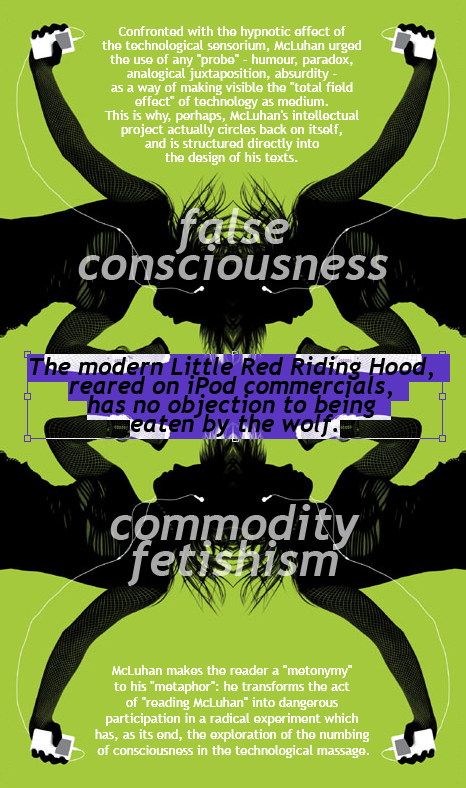
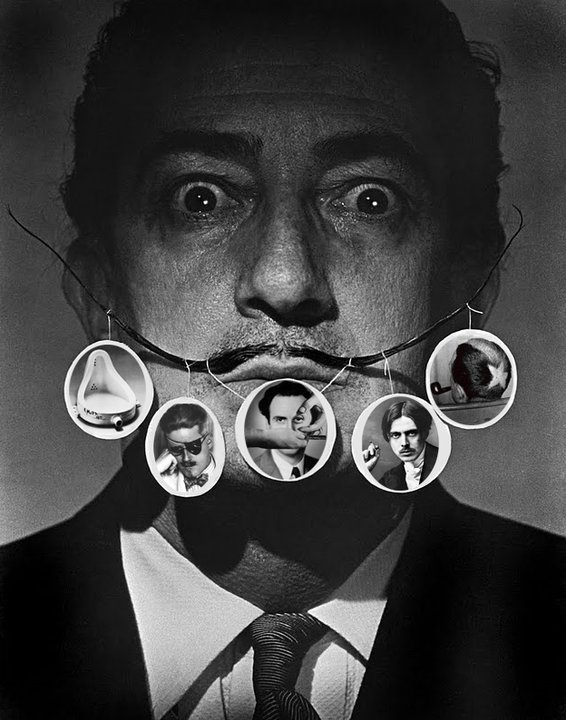
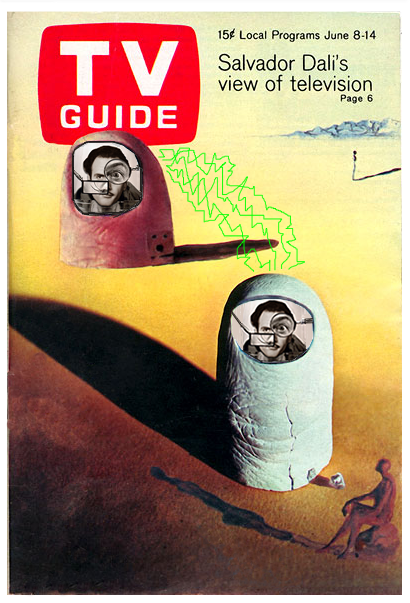
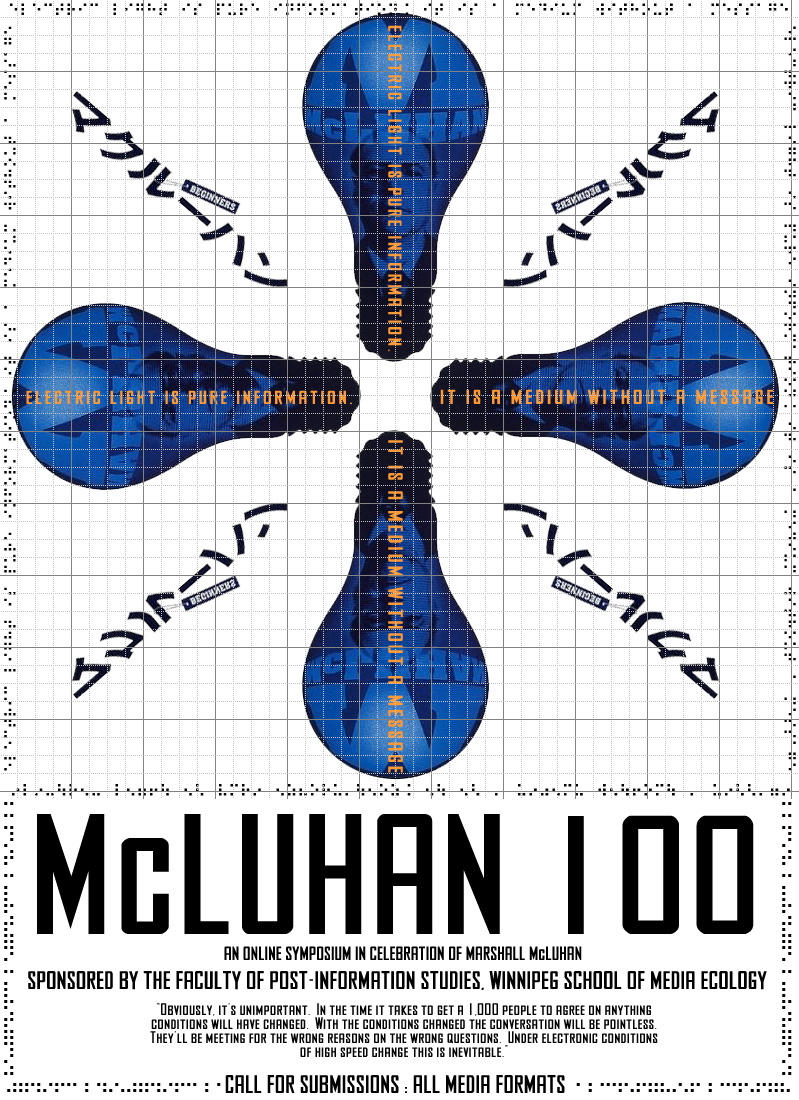
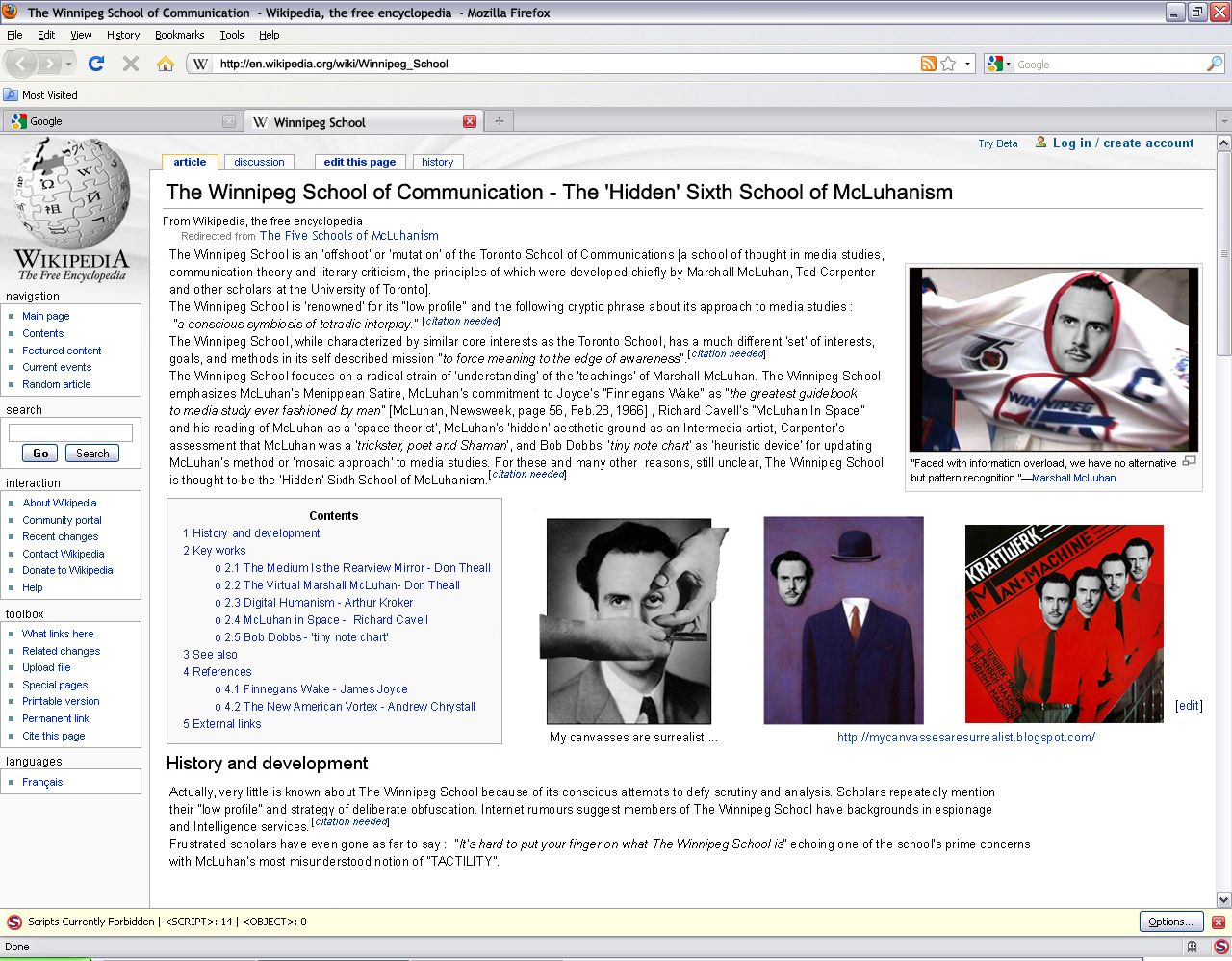
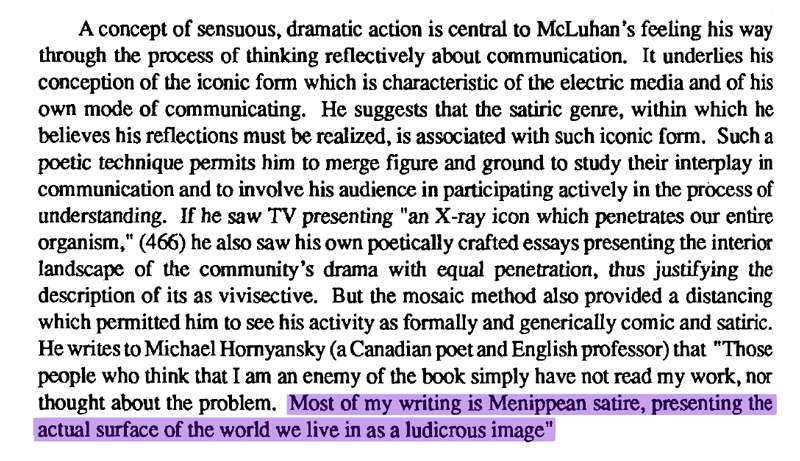
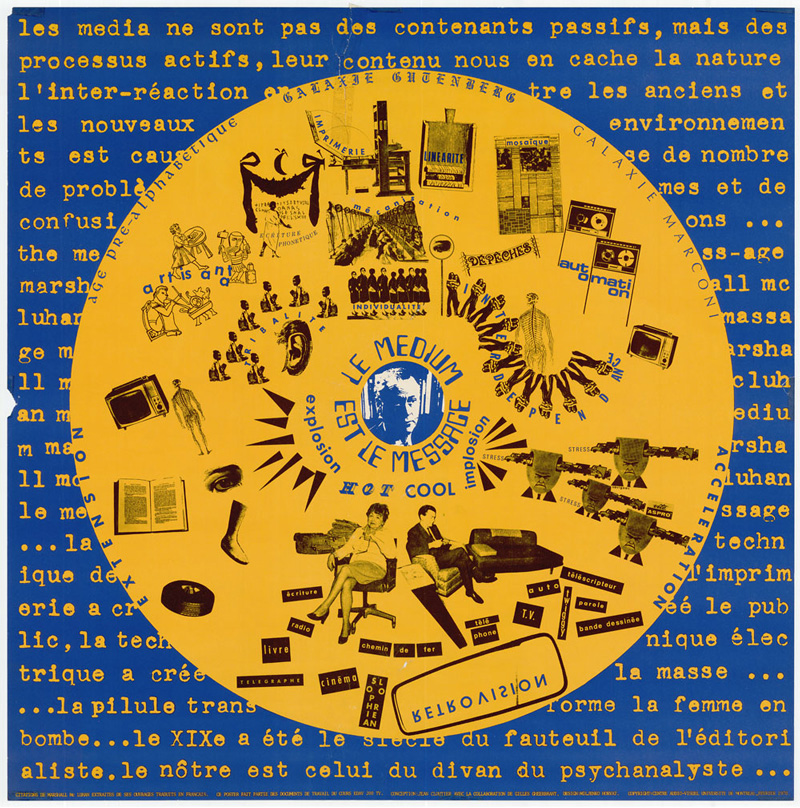
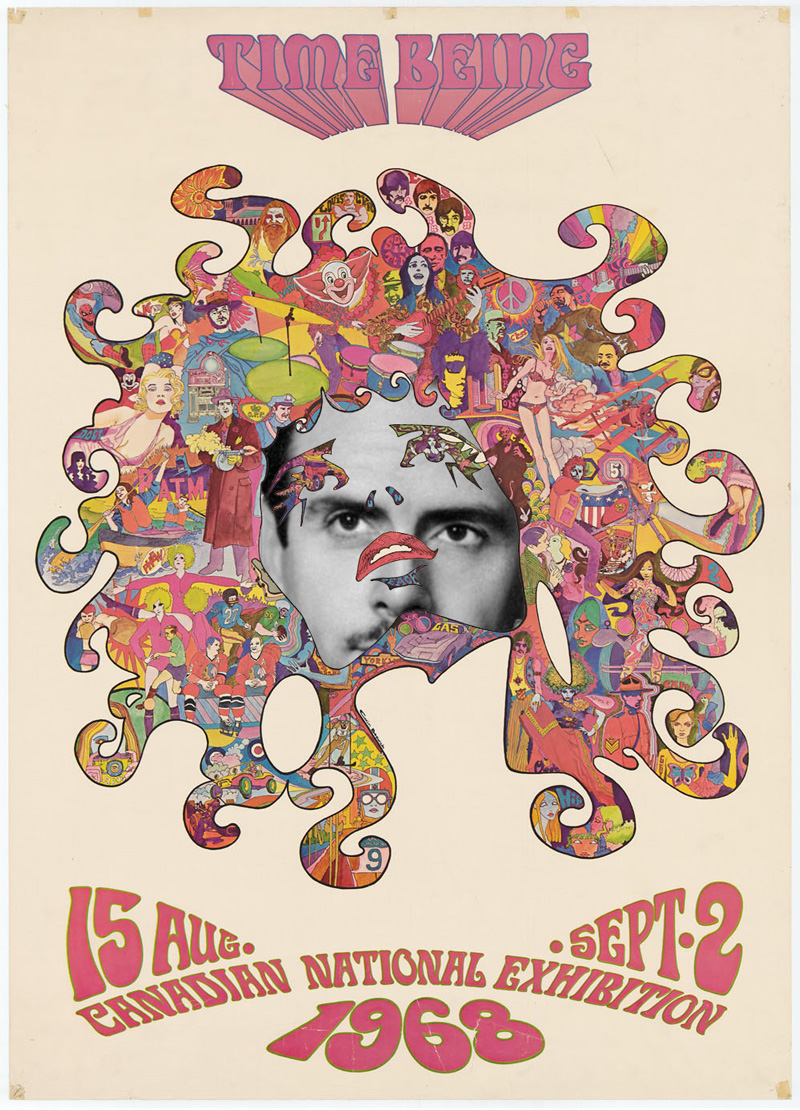
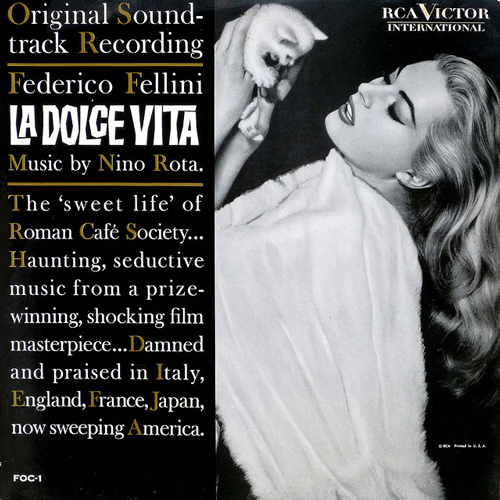

The following list of 'Menippean Topics' was found on several sheets of paper neatly tucked inside the record jacket of the Nino Rota soundtrack LP to Federico Fellini's 'La Dolce Vita,' which was purchased with about a dozen other records at a yard sale in The Annex neighbourhoood of Toronto, on a sunny Spring Saturday afternoon in 1986. As a sidenote, one of the other LPs purchased that day was a 'sealed copy' of Lou Reed's 'Metal Machine Music'2xLP, which was 'nabbed' for a measly 10 bucks. [Which co-incidently, has just been re-released in a digitally remastered edition on Sister Ray Recordings, and released on 180 gram Double Vinyl, AUDIO DVD and BLU-RAY.
MENIPPEAN TOPICS
The chief techniques of defining a work as Menippean satire have been three: either (a) simply by the formula, "a mixture of verse and prose," or (b) by a comparison of its contents with those of a known Menippean satire, or (c) by means of a "definitive" list of features. Each of these is inadequate to deal with the problem of definition of the form, Menippean satire. The first is inadequate both because it allows for the inclusion of works that are not Menippean, and because it excludes a great variety of works that are - that are either wholly in verse or wholly in prose. The second is inadequate because it too makes no provision for innovation. While the third (and most popular) likewise does not provide for innovation, it is also inadequate because critics have not agreed upon what such a list should contain and because, as this appendix illustrates, a complete and thereby definitive list would be unwieldy if it were in fact possible to compile one. Further, in all probability, no Menippean satire would use all of the ingredients of such a list. Moreover, all three techniques are inadequate because they result from appraising Menippean satire abstractly and descriptively, from a distance, and because they ignore the interaction of the satire with the reader.
As has been shown in Part One, descriptive or abstract approaches fail to come to grips with Menippean satire for the reason that it is inseparable from its effect on its audience. All of the features hitherto used to describe the form, or any example of it, may be regarded as tactics chosen by a Menippist to engage and retune the sensibilities of a reader by deliberately violating his sense of decorum in one or another way. If the catalog of features appears to grow with each period of Menippism, then, it does so because the Menippist has a new, or at least a different, audience sensibility to contend with. For each change of sensibility implies both an intensifying of awareness in some areas of experience and a blunting of awareness in others. Furthermore, the catalog may be enlarged for the Menippist by the development, either through his own work or others', of new literary patterns and techniques. This may in some measure account for the paradoxical fact that Menippean satire is at once highly experimental and highly conservative of tradition (it is mimetic).
The following list of Menippean topics does not attempt to be exhaustive: it includes little more than the commonplace features - e.g., those discussed by Frye, Williams, Bakhtin and Korkowski. While its size may demonstrate the futility of a merely descriptive approach, the list may serve another purpose. A structural study of these and other Menippean topics may eventually yield basic patterns of Menippean decorum which will in turn provide greater knowledge of how human perception is altered and managed.
TOPICS:
Almanackers. They were often used as the butts of the satires, as street-level philosophi gloriosi. Cf. The Owle's Almanacke by L.L. (Laurence Lyly). Astrologers have been attacked regularly by Menippists since Lucian's Astrologia. Cf. Nashe ("Adam Fouleweather"), Rabelais, Dekker.
Anonymous Author. The author's anonymity is apologised for in a fake introduction, for example, one written by the printer or bookseller who might plead any of several reasons. A common reason is that the author, a man of quality, does not wish to reveal himself as a writer of this sort of production. E.g.: Donne's Ignatius, His Conclave, Swift's Tale. In a variant, Joyce would often aver that his interlocutors in conversation, or passersby in the street, were composing and writing Finnegans Wake, not he.
Apologiae for the Work. One or more apologies are often used to establish relations to other Menippists, by citation, by reference, or by plagiarism. They can be used to establish tone, to banter with the reader, or to lay trails of red herrings. They may appear at the beginning of the work (as in Donne's Ignatius or in French editions of La Satyre Menippée) or anywhere inside as a digression (as in Harington's Ajax and Sterne's Tristram Shandy).
Autonomous Author. The author exults in a freedom to do whatever occurs to him. This topic is frequent. Examples include Lucian, Seneca, Fronto, Synesius, Erasmus (Folly), the Obscure Epistolers, Agrippa, Despérieres' dogs, Rabelais, Swift, Sterne, Byron. Sterne: "I have a strong propensity in me to begin this chapter very nonsensically, and I will not balk my fancy. - Accordingly I set off thus." (Tristram, p.74).
Autonomous Pen. The pen, or the act of writing, is remarked to take control of the author or narrative and to pursue its own course, observed and commented upon by the author who feigns powerlessness to control it. Ancient mock-eulogists had similarly feigned powerlessness to control their rambling oratory. E.g.: Epistolae Obscurorum Virorum (1516); Swift, Tale of a Tub; Sterne, Tristram; Nashe, Lenten Stuffe. Sterne has: "In a word, my pen takes its course... I write a careless kind of civil, nonsensical, good humoured Shandean book, which will do all your hearts good...." And: "But this is neither here nor there - why do I mention it? - ask my pen - it governs me – I govern not it." Tristram Shandy, ed., Work, pp.436, 416)Banquet. A favored Menippean device for displaying gluttony and other excesses, this topic also serves as both a strategy and a symbol of Menippean encyclopedism. The range of users is from Petronius (Trimalchio) through Rabelais to Finnegans Wake. (In the ballad, the party at the Wake becomes so rowdy that the corpse rises and joins in the fun.) The Wake is a banquet in many senses: of history, of learning, of languages, of personae, of words and puns, etc. Other examples may be found in Lucian, Convivium, the symposia of Varro, Athenaeus' Deipno-sophists, Macrobius, Beroalde's (Francois Beroalde de Verville's) Moyen de Parvenir (a philosophic banquet of the dead), La Satyre Menippée and Bouchet's Les Serées (1583-4). In the sixteenth century, the French seem to have enjoyed Menippean banquets particularly. Perhaps this topic is a direct link to the derivation of "satire" from satura lanx. See also Michael Coffey's article in the Oxford Classical Dictionary for a brief conspectus of ancient symposium literature.Blustering Narrator. The author asserts his authority (extreme), an assertion often couched in Herculean terms. This is often accompanied by a teasing of the reader and chitchat or feigned worry about the book's organization. Swift's is perhaps the most complete example. The hack, in Tale of a Tub, claims "Absolute Authority in Right, as the freshest Modern, which gives me a Despotic Power over all Authors before me..." and so on. This remark is contained in a "Panegyrical Preface," which is put in Section V of the Tale. The long line of Menippean precedents includes Lucian's Alexander the False Prophet, Cornelius Agrippa's De Incertitudine, Nashe's Lenten Stuffe, Burton's Anatomy (e.g., II.4.2.1, III.2.3, and I.2.4.7), and John Taylor. In A Voyage Round the World, Dunton demands, as he opens a new chapter, "Room for a Rambler - (or else I'll run over ye)."
Bookseller. The bookseller is used as an alternative persona by the (sometimes anonymous) author. In this guise, remarks can be made that bridge lacunas (q.v.) in the text, to provide prefaces or editorial marginalia or footnotes, or all of these. Swift's Tale is a representative example; others include John Taylor and Dunton ("Nimshag's" treatise on gingerbread). The anonymously-provided Catalog appended to C.G. Finney's The Circus of Dr. Lao is a more recent example.
Catalogs and Inventories. This digressive device shatters narrative and disrupts any attempt to establish single point of view or logical sequence. The arch-practitioners are Rabelais and Joyce. In the more learned writers, it is used as a device for moving the basis of the discussion from efficient to formal cause of an event or situation. It can also become a linguistic activity of the text itself, as with Joyce's thunders. Korkowski (p.242) cites Rabelais as the inventor of this topic and attributes its invention to the "new directions" in reading made possible by printing. This topic would seem to be another descendant of satura lanx, and to be writ large in other topics such as the banquet and encyclopedism. In its relation to the latter, it is often used to lampoon the cullings, anthologies and sham learning (reduced and systematized for efficiency) promoted by the gloriosi. The catalog technique is essentially grammatical. Catalogs can (and do) include anything - the contents of pockets, grocery lists, pawnshop receipts, ships' names, book titles (real or fake or both).
Descent into the Underworld or Afterlife. This topic is related to those of the tour through hell (or heaven), the fantastic journey, travel to the moon, Dialogs of the Dead and imaginary conversations (Cf. Landor). A fundamental Menippean strategy directly related to Cynicism, the descent is useful for exposing folly and pretension in this life by way of the "democratic" levelling and occasional comeuppances of the next. Swift's tour of the madhouse is a variety of the tour through hell: several of his "madmen" are doing, by their own inclination, exactly what the damned in other Menippean satires - particularly Dunton's Second Part of the New Quevedo - were doing as a punishment in the next world. This topic is especially used against the philosophi gloriosi, intellectual and social cranks, and snobs of all kinds. Menippus probably wrote one: certainly his two greatest ancient imitators did so - Varro and Lucian. Seneca's Claudius is of this type.
Diagrams and Drawings. The author reproduces in the text engineering plans for assembly of real or imagined machines, that may or may not be referred to in the text of the satire, and that may or may not work when assembled according to instructions (which may or may not be provided). This topic is often used to lampoon physicists, engineers and other "projectors" and schemers. In Harington's Ajax, to cite one example, none of the parts in the "disassembled" drawing can be found in the "assembled" drawing.
Dialogs of the Dead. A variant of the topics of Banquet and Descent into the Underworld, this device allows a cast of characters widely separated in time to be brought together. Their conversation, sometimes with the narrator, may run to matters concerning the audience for the satire, or each other, or trifles, or all of these.
Digressiveness. This has been called the heart and soul of Menippean satire. It is achieved in many ways. Nearly every Menippean topic is a form of digression from the normal or expected, ranging from violations of stylistic decorum to violations of narrative sequence, of time (Dialogs of the Dead), of probability (the author writes before birth or after death), of physical size or capacity (Rabelais), and so on. This can also take the form of repeatedly promising to come to the point, and never doing it, as in Harington, Dunton, Swift and Sterne, for example. The point of a passage in Finnegans Wake is seldom found except after extreme labors with the text, and then it may be an irrelevancy. For the Menippist, the labors are the point. In a variant, John Fowles provided several alternative endings to The French Lieutenant's Woman. Inherent in the structure of the frame tale (Milesian tale) and the double-plot epyllion, digressiveness is a strategy for attacking and adjusting the reader's sensibilities. It is a form of structural ambiguity.
Diogenes. He and other Cynic philosophers may be used in a satire as key characters, or may just be referred to now and then, or they can be used to provide running commentary from the sidelines on a satire. Rabelais gives his reader "licence" concerning his "pantagrueline Sentences" (a satire on Peter Lombard et al.) "to call them Diogenical." He parodies and greatly expands the account in Lucian's How to Write History of Diogenes' tub (Prologue to the Tiers Livre). The Tub, far more to Menippists than just clothing, reappears in Swift's Tale. A "tale of a tub" was, in the sixteenth and seventeenth centuries, an epithet for a kind of writing "suited to flimflam, idle discourse and a tale (sic) of a roasted horse" (A.C. Guthkelch and D.N. Smith, eds. of A Tale of a Tub). Equally, doggishness is invoked, as by Dunton:
"There stood Diogenes the Cynic, snarling at two Devils, that were going to Muzzle him, for he was so abominable Currish, he bit the Devils that came near him, His chief Clamour was... the Devils to quiet him, had promis'd to release him in Fifty years." (Second Part of the New Quevedo, p.78).Menippus also appears frequently in Menippean literature, e.g., in Lucian, or in Butler's "Hudibras in Prose," Mercuriis Menippeus. Burton's use of Democritus is proverbial. This topic is related to the establishment of the pedigree of a satire, as to Dialogs of the Dead and Digressiveness of time. It allows the Cynic spirit to be injected directly into the work.
Do it Yourself. The reader is told to add to, subtract from or rearrange the materials of the text to suit himself. In a muted form, the reader is advised to skip certain chapters or sections of the work as worthless or as potentially offensive (as Sterne, to his sensitive female reader). In another variation, the reader is told to refer immediately to other places in the text, which may be real or imaginary, apposite or not. An aspect of digressiveness, this device breaks narrative and continuity and helps to attract attention to the act of reading and to the text as an artefact. Thus it is related to the topics, lacuna-making and lacuna-pretending. Swift: "The necessity of the Digression will easily excuse the length; and I have chosen for it as proper a Place as I could readily find. If the judicious Reader can assign a fitter, I do here empower him to remove it into any other Corner he pleases. And I so return with great Alacrity to pursue a more important Concern." Sterne opens Vol. V, Chapter X by inviting the reader to fill in his own reasons for the pause in Trim's oration.
Doggishness. This topic includes dog-conversation, dog-philosophy, and other references to dogs. Directly related to the Greek pun on dog and Cynic, this topic serves to establish Menippean pedigree and to introduce the Cynic attitude and tone into a satire. Cf., Lucian, Rabelais, Byron, and others. "The fourth dialogue in the Cymbalum Mundi of Despérieres is a conversation between two dogs, Hylactor, or 'Barker,' and Pamphagus, or 'Devour-all,' who are well-versed in the anti-conventional sentiments of early Greek Cynicism; they look upon the human race with snarling disdain." (Korkowski, p.231)
Euphuism. Though not necessarily a Menippean topic, Euphuism yet has the potential to be one and exhibits a number of Menippean features including the display of learning, the use of incidental verses, and (sometimes) the dialog form. Euphuism was practised chiefly by John Lyly, William Painter, Thomas Lodge, Robert Greene and Nicholas Breton. Greene moved on to Menippism, with his Planetomachia and a series of "deathbed" productions. Whereas Menippean epistolary writings tend to come from the next world, Euphuistic "letters" are exchanged between romantic heroes and heroines, their friends, rivals, parents, and enemies. There is little mock or ridicule of learning in Euphuism.
Excess Baggage. Under this topic may be grouped all manner of illusions, pretensions, false learning or assumptions, etc., that are to be shed. This topic is a typically Cynic aspect of Menippism. Antisthenes, a student of Socrates and the man generally regarded as the first Cynic (in belief if not in outlandish behavior) replied, on being asked what learning was most necessary, "how to get rid of having anything to unlearn." Lucian's Charon observes, "... Hermes, you see what they [normal people] do and how ambitious they are, vying with each other for offices, honours, and possessions, all of which they must leave behind them and come down to us with but a single obol... Nothing that is in honour here is eternal, nor can a man take anything with him when he dies; nay, it is inevitable that he depart naked..." (Lucian, Vol. II, p.437)
Fake books. In some Menippean satires, these are promised to the reader (and never delivered). In variations, they are alluded to or cited as authorities, or whole libraries are invented (as Rabelais' Thélème). Mock erudition is one of the devices for satirizing academic or learned pretentiousness. Examples of this topic include: Harington's "tenth decad" of "the reverent Rabbles;" A Catalogue of Books of the Newest Fashion, "to be sold by Auction, at the Whigs Coffee-House, at the Sign of the Jackanapes, in Prating Alley" (included in The Harleian Miscellany, V.6); Thomas D'Urfey's An Essay Towards the Theory of the Intelligible World... (etc.); Burnet and Duckett's A Second Tale of a Tub: or, the History of Robert Powel the Puppet-Show-Man (they "refer the Dispute" - over whether the dead have sensation - "to my Eighteen Volumes in Folio coming out as a Comment upon Duns Scotus"); Johann Fischart's Catalogue Catalogorum perpetuo durabilis. Das ist: Ein Ewigwerende, Giordianischer, Pergamischer und Tirraninoschar Bibliotecken gleichwichtige und richtige Verzeichnuss und Registratur (1590), and countless others including the Obscure Epistolers, Erasmus, Swift, Sterne, Carlyle's Sartor Resartus and Finnegans Wake. Swift opens the Tale with a list of fake treatises, "which will be speedily published."
Fake Preface. Let this topic include all manner of fake prefatory and introductory material. The locus classicus for this topic is Swift's Tale: it presents the reader with a (digressive) dedicatory note "to the right Honourable John Lord Sommers" (by "the Bookseller," as the Tale was anonymous); a note from "the Bookseller to the Reader," citing Menippean relatives; "the Epistle Dedicatory, to His Royal Highness Prince Posterity" using the Senecan/Lucianic claim of truth; "the Preface," lengthy and digressive; and "Sect. 1 - the Introduction," lengthy, digressive, and replete with (fake) lacunae, citations and descriptions of fake texts. Sterne places a (digressive) dedication at the end of Vol. I, ch. VIII, and uses the next chapter to comment upon and slightly emend it: "... the rest I dedicate to the MOON, who... has most power to set my book a-going, and make the world run mad after it..." His "the Author's Preface" appears in Vol. III, ch. XX. See also D'Urfey's Essay: the section "Of Prefaces" is not a preface; near the end of the book a pointing hand indicates the centred message, "HERE ENDETH THE PREFACE."
Fake Table of Contents. This topic is of a piece with the preceding one and includes misplaced Tables of Contents (as in Du Cliche´ á l'Archetype: la Foire du Sens, where the chapters are in alphabetic order, and the Table under T). Principally, however, this topic refers to a Table of Contents that lies, that promises matter and chapters not in the book. D'Urfey sets out a prefatory table of contents for his Essay, announcing "sections" never to be found, or given in vastly different form.
Forcing the Reader to Think. This is basic to all Menippean strategy and derives from the Cynic demand to "wake up!" A sure means of accomplishing this is by challenging the reader's assumptions and by violating his expectations about narrative continuity, truthfulness, decorum of style, and literary conventions (e.g., that diagrams refer to textual matter, or that promises will be fulfilled). One means is Joco-Seriousness (q.v.), the expenditure of lavish erudition on trifles and vice-versa. Another means is using paradox (including paradoxical encomia) to involve and intrigue the reader, for intellectual detachment and reflection.
Gibberish. Properly one of the language topics, this includes nonsense words, phrases, sentences or paragraphs. The result can be hilarious. E.g., the scholarly labor thus far expended in attempts to decipher the "languages" in Gulliver's Travels are a Menippean "side effect" of that satire whereby the scholars' efforts and reports become an additional "chapter," in which they satirize themselves unwittingly and unmercifully (because they're not playing). Users range from Rabelais' "Corrective conundrums" (Gargantua, 2: gibberish punctuated by gaps), to Lewis Carroll's Jabberwocky, to Finnegans Wake, which some critics argue is entirely gibberish, "a monstrous joke."
Glosses. This topic embraces fake glosses, false erudition, irrelevant glosses, and includes similar play with footnotes and other marginalia and "editorial" digression from the text. Examples: Lyly, The Owle's Almanacke (mock-serious marginalia), Swift, Dunton. Sterne used a variation by putting his characters into tableaux (his "Shandean way of writing") for sentences, paragraphs or even chapters at a time, so he could mount digressive hobby-horses. Joyce used it all in the "Triv and Quad" chapter of the Wake. Often fake and real are interspersed, leaving matters to the reader to sort out. Swift glossed the Tale with one of the Tale's critics' remarks. This topic is clearly related to Digressiveness.
Groping. There are several forms: one is for the "mot juste." Alternatively, the author either pretends to have lost his way, perhaps due to digressions, and to be unable to find it again (often in Sterne); or he pretends to reach for the ineffable and to lose it, while remarking to the reader that in any case no direct understanding is possible. Korkowski points out (p.281) that Beroalde goes a stage further in noting that his own work, which admits only of being a "moyen de parvenir" and not an actual arrival, "is more honest than other books which offer definitive statement but no comment on the lack of ontological certainty in reading and language":
"Sur quoy je vous diraiy un grand secret, et puis l'autre; c'est que vous ne trouverez point en cecy du truandage de pedantisme, comme des autres, pleins du ravaudage de folle doctrine qui n'aporte pointe á disner. Et davantage, je vous diray le secret des secrets; mais je vous prie, afin qu'il soit secret, de vous embeguiner Ie museau du cadenac de taciturnité, et ecoutez: CE LIVRE EST LE CENTRE DE TOUS LES LIVRES. (Le Moyen de Parvenir, p.32)
Honesty. "I promise you purest truth," followed by whopping lies. A basic and frequent topic, this includes all the varieties of misrepresentation, misleading and fakery. Lucian's True Story is the touchstone.
How to Read the Book. The reader is given clues or instructions by the author. A feature of most Menippean satires. E.g., Sterne Vol. I, ch 13 (instructions promised), Rabelais, Byron, Joyce.
Inability to Edit Anything Out (feigned, of course). This is related to such other topics as Catalogs and Encyclopedism. Examples: Harington, Sterne, Nashe, Swift.
Joco-seriousness--see Spoudogeloion.
Kidding or Teasing of a Female Reader. Digressive chitchat with female readers (of delicate sensibilities), which may include lines that the writer supposes will come from the reader. This topic is best exemplified in Beroalde and Sterne. Cf. Tristram Shandy I.vi; I.xviii, and passim, to "Sir," "your Lordships," "Madam," or "Dear Jenny." Cf. especially the thinly-veiled hints of sexual horseplay he gives her, at p.226, facing the Marbled page (Word, ed.). Beroalde litters the Moyen with such asides, as does Bouchet. Dunton does the same.
Lacunae. Cf. Digression. The fake lacuna, a form of caprice with narrative continuity and order, is used commonly by Menippeans to tease the reader (Cf. Beroalde, Swift, Sterne). Sterne is the handiest English paradigm. He used blank pages, black pages, marbled pages ("motley emblem of my work," III.xxxvi), and omitted chapters.
Carlyle used a new variation: he told the reader that the materials for the 'Autobiography with "fullest insight"' of Teufelsdrókh arrived in the editor's hands in six "considerable PAPER-BAGS, carefully sealed, and marked... with the symbols of the Six southern Zodiacal signs." These contained a hopeless jumble of assorted Sheets, Shreds and Snips on every imaginable trivial and inconsequential subject. (Sartor Resartus, ch.XI) D'Urfey is replete with chasms, even to a section titled "the Method of Making a Chasm or Hiatus, judiciously; the great Reach of thought requir'd for the Contrivance thereof, together with the Difference between the French Academies and the English."
Language. A variety of topics appear under this heading, which designates matters pertaining to the language found in Menippean satires.
Bad Language. Mis-users of language are often a target of Menippean satires: this is an aspect of the Menippists' relation to grammar and its concerns. Korkowski: "One particular fraternity pretending to learning that has incurred Menippean censure, regardless of periods, is the mis-users of language: the rigid grammarian, the sophist who deals in glittering speech, the hack poet, the fanciful etymologist, the word-torturer, and the 'systematizer' of language are the genuine bétes-noires of the Menippist... on the theme of correct language and in degree of linguistic brilliance, Menippism as a species of controversy has no equal in quality. Bonaventure Despérieres' Cymbalum Mundi, Beroalde de Verville's Moyen de Parvenir and Swift's Tale of a Tub are to the problems of words what the very greatest thinkers' works have been to problems of philosophy." (pp.61-62) Cf. Pope's Peri Bathous (part of the "Martinus Scriblerus" project that produced other, independent Menippean productions, e.g., Gulliver's Travels). Finnegans Wake uses every rhetorical and grammatical device known, and every resource of the language-as-storehouse-of-experience. Joyce noted that he had to "put the language to sleep" to obtain the necessary freedom. The linguistic hi-jinx of the Wake are not without precedent, however. Rabelais used the Menippean form of language-tinkering. Apuleius, Martianus Capella and Alan of Lille wrote the most playful (to a Menippean; "tortured" to the sober critic) Latin extant. Following Rabelais, Etienne Taburot published his Les Bigarrures, a playful and exhaustive tampering with the humorous possibilities of disrupting the ordinary conventions of logical structure, sentence structure, word ordering and even letter orders; puns, obscenities, parodies of printed symbols, and relentless para-logical hoppings from one word to some strange equivalent or associated term, occur. His displays, however, tend to be little more than catalogs, set out one after the other, of ingenious lingual transpositions. (Korkowski, p.267)
Deluding Word. Words' numinosity is related to the topic of their correct usage and is persistent in Menippean satire. (All of the language topics - chief Menippean concerns - show the direct relation of these satirists to grammar.) Cf. the Obscure Epistolers, Martianus Capella (the aptness of the marriage of Mercury and Philology - rhetoric and grammar), Alan of Lille's De Planctu.
Fake Etymologies. This kind of grammatical horseplay by Menippists satirizes the sober ineptitude, clumsiness or superficial learning of the dialectician who tries to take over grammar with logic and philosophy. Equally, it is used to lampoon the inept or unlearned grammarian. Mostly in use since the nominalist/realist debate, it is related to the definition or the absolute meaning, or the absolute nature of things. Cf., Beroalde, Despérieres, Rabelais, Sanford's Mirror of Madness, Swift (e.g., "Antiquity of the English Tongue"). Its use is frequently accompanied by a display of erudition (real or fake, or both) of authorities in support of or contending about the etymologies. "The abnihilization of the etym" (FW 353.22). Related to Nothing.
Gibberish as language (see above).
Letters of the alphabet, as things, as praised, blamed, at peace or at war with each other, etc. This topic occurs often, from Lucian (The Consonants at Law) to Joyce (FW 119-123). Punctuation is also a topic, similarly handled (FW 124, for example), as are parts of speech. Cf. Guarnas' Bellum Grammaticale, Sterne on verbs (copular; copulation) and "auxiliaries," Alan of Lille.
Mixed Languages. This topic refers to the use of more than one language in a text, perhaps without adequate (or any) justification. A form of digressiveness, it can be related to tactics of violating decorum, as each language embodies the perceptions and experiences of the user culture, and it can include fake language (as in Gulliver's Travels). Among others, Varro and Burton display polyglottism. Sterne provides Slawkenbergii Fabella at the outset of Vol. IV (Tristram Shandy), accompanied by a simultaneous translation on the facing pages that is six times as long as the Latin. Joyce inserted sections in Latin and in French into Finnegans Wake, in "Finneganese," and his puns and thunders use fifty or more languages.
Prose-Verse Mixture was used in antiquity as the hallmark of Menippean satire and is still adhered to as a sine qua non by many classicists and critics. A digressive technique related structurally to both etymologies of satire, the mixing of verse with prose constituted a violation of decorum calculated to shock the sensibilities of the percipient reader or hearer into alertness. It is often combined with Joco-Seriousness (and related topics) as high style is employed on base matters, and vice-versa. A variation was the sprinkling, through a prose text or dialog, of lines and verses misappropriated (and misapplied, used on quite different subjects) from ancient or epic poets. Cf. Lucian's Charon.
Words as Gestures, and vice-versa. Words and language are used on a supra-semantic level where they shed their "contents" of usual meanings and function as eloquent acts. This topic is an aspect of all Menippean language-tinkering: the prime example is Joyce's thunders. For the reverse, gestures as words, see Rabelais, Gargantua 2; Pantagrual 19. In either variation it is a form of digression from normal accidence and syntax.
Words as Things, and vice-versa. The preceding topic draws attention to eloquence inherent in the formal character of utterance: this topic deals with the relation between language and artefacts. Both topics are grammatical and formal; though serious, this device is most often used ludicrously. Cf. Swift, Gulliver's Travels, Tale of a Tub. Things-as-words (or events) stand in direct relation to the Medieval grammarian's techniques of exegesis of the Liber Natura, a parallel text to the Liber Scriptura, echoes of which survive and persist in the poets. Cf. Don Juan, III.88 (note the Menippean-Cynic tone):"But words are things, and a small drop of ink, Falling like dew, upon a thought, produces That which makes thousands, perhaps millions, think; T'is strange, the shortest letter which man uses Instead of speech, may form a lasting link Of ages; to what straits old Time reduces Frail men, when paper - even a rag like this, Survives himself, his tomb, and all that's his."The written or printed word is a thing, inarticulate in itself.
Laughter. Laughter may be Democritean (e.g., Lucian and Burton), Diogenical (e.g., Rabelais), Wakean ("Lots of fun at Finnegans Wake") or routinely Cynic-Menippean. Both a topic and a tactic, laughter is indispensable to Cynic joco-seriousness, to retuning the reader's sensibilities by means of an engendered playfulness, and to curing him of undue or misplaced sobriety. In this regard it is related to topics of Digressiveness and of violations of decorum. Bakhtin has this as the quintessence of carnivalism, which he identifies with Menippism. Burton resounds with Democritus' laughter. Cynic laughter and wit runs through Beroalde, who notes in his first chapter that he directs laughter at the philosophers "because mirth must be restored." There's "lots of fun at Finnegans wake."
Learning. Cf. Encyclopedism, Fake Books. Respect for maintenance of the traditions (grammatical) of genuine learning and encyclopedic wisdom is concealed under attacks on all forms of easy, simplified or systematized "learnedness," pseudo-intellectual and philosophical extremism and universalising. Examples: Menippus, Varro, Petronius, Seneca, Lucian, Erasmus, Rabelais, Swift, Flaubert, Joyce. The Scriblerians (Pope, Arbuthnot, Swift, Gay) aimed to produce periodically a Works of the Unlearned: Flaubert got somewhat farther with the project with Bouvard. Cf. Sterne on noses (gnosis).
Medicinal. This topic is related both to the sanative powers of satire in general, and to those of Menippean satire in particular. Menippean authors frequently refer to their satires as having curative properties. This can range from generalities, such as "Written for the Universal Improvement of Mankind" (Swift, title page of the Tale, spoofing the gloriosi), to more pointed claims that the work is a "medicine," as in Rabelais, or in Burton, or Dekker:
"… more potent, and more precious, than was ever that mingle-mangle of drugs which Mithridates boyld together. Feare not to tast it... the Receipt hath beene subscribed unto, by all those that have to do with Simples, with this moth-eaten motto: Probatum est: your Diacatholicon aureum... pledge me, spare not... take a deep draught of our homely counsel." - Dekker, The Guls Horne-Booke (Non-Dramatic Works, Vol. II, pp.213-214)Memory of Time before Birth. The author discusses (as a spectator) events that occurred before his birth. Sterne (Tristram Shandy is not born until well into the third book) presents a mass of irrelevant detail on the events that preceded and surrounded both his narrator's conception and his birth. Dunton rambles through memoirs of his earliest years, including the years before he was born: chapter one of Vol. I treats "Of my Rambles before I came into my Mother's Belly, and while I was there." His rambling narrator, Kainophilus, adds a twist to the theme, complaining that he made no notes on the moment of his birth (though he made, somehow, plenty of notes in utero) as he was born without anything to write with - in fact, "Because I was dead born, I can't remember anything on it to save my life."
Method. Dialectical systematizing and universalizing is a common butt of Menippists, and as such continues the grammarians' attacks in the battle of Ancient vs. Modern. Cf. the Cynic disdain for all forms of easy or systematic (abstract) answers to any of life's problems, which result in the individual not thinking for himself. E.g., Swift spoofs the gloriosus lightly in presenting the Tale "for the Universal Improvement of Mankind," and savagely in the stupidity of his hack. Sterne lightly but thoroughly dissects Locke, Carlyle the German gloriosi. The structure of Burton's Anatomy parodies post-Ramist branched-logic systems. Cf. Moderns.
Mock Eulogy. Taken directly from epideictic rhetoric and the topics of laus et vituperatio, the paradoxical encomium goes back at least as far as Gorgias' Praise of Helen. Just at what point this enters Menippean lists is hard to say. One of Varro's Menippean satires has the title, "Two asses will praise each other" - Mutuum muli scabunt. Lucian wrote many mock-eulogies, e.g., Phalaris I and II, Peregrinus, Alexander, Saltatio and Muscae Laudatio. Cf. also Erasmus' Praise of Folly, Panurge's "Praise of Debtors" (in Le Tiers Livre, ch. 22), the "harangues" of La Satyre Menippée (1594), Burton's Anatomy (III.2.l.l), Swift's praise of Madness in the Tale, Nashe's praise of the red herring in Lenten Stuffe. Further examples in Rabelais and others are discussed in Colie, Paradoxia Epidemica. Sterne is careful always to praise Locke while he demolishes his theories. Korkowski notes that "after Lucian (and even before him) the satirical eulogy is identified with this Menippean tradition by knowledgeable authors. To men of the Renaissance, for example, Lucian's mock-praises appeared germane to snarling Cynicism; almost anything by Lucian, for that matter, was regarded as proceeding from a common Menippus-Lucian temperament... That the mock-encomium and 'other' Menippean forms were perceived as identities can be gathered from Erasmus' epistle to Thomas More, introducing the Praise of Folly..." (p.98)
Moderns. The "moderns," or dialecticians (gloriosi) in all ages, are a target of Menippists. The line of attack runs through Menippus, Varro, Petronius, Lucian (e.g., The Sale of Philosophers), Erasmus, Cervantes, Rabelais, Voltaire, Butler, Dekker, Nashe, Swift, Sterne, Carlyle, Flaubert and Joyce. Cf. Method.
Musical Notation. The verses interspersed with the prose frequently have the potential of being used independently as songs. However, this topic refers particularly to an interruption of the running text by offering the reader the notes and musical notation of songs, with or without the verses, and which may or may not be musical or euphonious. Examples include Bishop Francis Godwin's (1638) The Man in the Moon (the moon-giants discourse in a wordless language of music made up of standardized tunes, several pages of which are presented to the reader as a message of moment to Englanders) and Cyrano de Bergerac's Histoire Comique des Etats et Empires de la Lune et du Soleil (his moon-people are like Godwin's: they speak a language of tunes that appears in the text as musical notation). Korkowski notes (p.330), "this was not new in Menippean satire" and refers the reader to the Sermo Quodlibeticus de Podagrae Laudibus in Dornavius, and Taburot's Bigarrures for precedents. Harington includes pages of music in Ajax. Joyce includes the written melody for "The Ballad of Persse O'Reilly" in Finnegans Wake (pp.44-47), and two other written melodies in the "Ithaca" chapter of Ulysses.
Mutilated Text. The author, either as himself or in the person of a publisher or editor or critic, presents or comments upon a text that he claims is corrupted, mutilated or otherwise interrupted by lacunae. See Lacunae.
Natural Scale. Inseparable from the other Cynic topics, this one refers to Cynic insistence on not exceeding the limits of human scale, which includes constant attention to our human frailties, limitations, susceptibilities to pride, self-aggrandizement, and so on. In Menippean satire, this is an aspect of the Cynic wind that blows through the satire as much as it is an aspect of the purposes of the satire. The reader's sensibilities are to be so revivified that he becomes aware of his deviation from, and will develop a preference for restoring, human or natural scale in his activities, psychic and social.
Non-sequitur. Deliberately used by Menippists, the non-sequitur is related to lacuna-making, digressiveness and all forms of interruption of narrative sequence, q.q.v. Non-sequiturs are the order of Beroalde's book. To make his reader aware that "straight-line" narration is a purely arbitrary order, Sterne, sending up Locke, denies his reader what is expected, interrupts the continuity of narrative logic at every turn, displays the pieces, and then asks innocently what they are and how they should go back together. In Ulysses, Joyce found new variation on this topic in the technique of "simultaneous parallels" with Homer, as well as in the discontinuities of "stream of consciousness."
Nothing. This topic, a frequent subject in Menippean satires, includes writing on recondite trivialities ("nothings"), often with a display of immense erudition, or, literally, writing whole chapters on "nothing." This latter is related to satirizing gloriosi logic-choppers who cut matters so fine that their weighty systems are brought to bear on "nothings." Dunton's Voyage offers "admirable and surprizing Novelty of both Matter and Method; a Book made, as it were, out of nothing, and yet containing every thing..." Ulysses and Finnegans Wake may equally be said to be made of "nothings" and yet to "contain everything." Cf. also Nashe, Sterne. Most Menippeans try their hand at this topic at one time or another as sustaining it calls for high wit and inventiveness. Swift: "I am now trying an experiment very frequent among modern authors; which is, to write upon nothing; when the subject is utterly exhausted, to let the pen still move on; by some called the ghost of wit, delighting to walk after the death of its body..." (etc., from the "Conclusion" to the Tale). Rabelais lavishes formidable amounts of attention upon bagatelles (as does Macrobius on the egg, and Athenaeus on odd kinds of fish). Panurge's decision to marry, for another example, becomes the focus of an enormously prolonged, prolix and pettifoggish debate leading to nothing.
Parody of New Forms. The chameleon-like and mimetic nature of Menippean satire, which contributes to the impossibility of accounting for it descriptively, gives it immense flexibility and adaptability to new forms and new situations. As soon as new genres or modes or media for expression appear, Menippists quickly adapt to the new form and begin to explore its satirical possibilities. This was done, for example, by Rabelais, Nashe, Dekker and Aretino, as Korkowski points out (p.225). Rabelais puts on the pretensions of the new "learned" genres made popular by printing. Somewhat later, Swift creates hiatuses with a new symbol, the asterisk, and Sterne toys with all the devices of the book, even to turning it inside out by putting the marbled end-papers in the middle. Flaubert aped the popular press in declaring his ideal novel would be all style and no content. Joyce used cinematic technique in Ulysses and remarked that the Wake was written "after the style of television." The study of Menippism in modern media has not yet begun. I suggest that there is no reason why it should not have expanded beyond the confines of written or printed texts once audiences were formed by and could be hypnotized by other-than-literate media. One might begin such a study with Orson Welles (Radio), Woody Allen (Film), and Steve Allen or Norman Lear (Television). The mind boggles at what havoc a determined (Cynic) Menippean might wreak with the telephone, or computer data-bases and systems analysis, or satellites. We may yet find out. See Printing.
Philosophus Gloriosus. He is the favorite Menippean whipping-boy. Philosophers (dialecticians) are open to Menippean attack on several grounds. First, their whole enterprise is traditionally based upon abstraction of ideas and reasoning, which the Menippist can castigate as a form of undue exaggeration and equally as a retreat from reality. Second, their reliance on logic as a tool and the fine distinctions and rare abstraction into which that often leads also fuels the Menippean fire. The grammatical side of Menippean satire would have at the gloriosi in any case, as a skirmish in the quarrel of Ancient with Modern. Those are general terms: particular targets are more usually members of fashionable and pseudo-intellectual groups, as in Seneca's Apocolocyntosis (the ignoramus Claudius and his retinue of hack poets) or Petronius' Satyricon, or in Erasmus or Lucian, in Hudibras, or Tristram Shandy. Swift sent up one group in the Tale, quite another (the equivalent of the mad scientist) in Gulliver. Carlyle takes aim at the invasion of German philosophy in Sartor Resartus (tailors are second only to philosophers as Menippean targets), and Wyndham Lewis at Bloomsbury pretentiousness in his Apes of God. The pseudo-learned of all sorts are the favorite quarry: these fakes - the real gloriosi - have usurped the place of the genuinely learned, have bamboozled the less educated, and have used the appearance of learning and wisdom for worldly gain. They are as thieves and polluters. In our time, the bestseller writer is as much a gloriosus as was Locke in Sterne's.
Printing Conventions Trifled With. Cf. Parody, above. This topic concerns horseplay with the conventions of printed books. Practitioners include Rabelais, Nashe, Harington, Sterne, Joyce. In a variant, Rabelais (as Swift, etc.) claimed that his text had been botched by incompetent printers (a common enough complaint even now by authors): "For the benefit of the warriors I am about to rebroach my cask, the contents of which you would sufficiently have appreciated from my two earlier volumes if they had not been adulterated and spoiled by dishonest printers..."
Projectors as targets. This refers principally to the mad scientists and crazed philosophers of Swift's time (Cf. Philosophus Gloriosus): they seem to be accounted as of the same family as astrologers, alchemists, etc. Swift's "Grand Academy of Lagado" has an ancestor in Joseph Hall's Mundus alter et idem, an account of travels to and the fabulous goings-on at "Terra Australia Incognitis." The most populous region of Australia, Fooliana, has a university, called "whether-for-a-pennia," where specimen sciences are taught, including penny astrology. In one college, "Gewgawiasters" are busy inventing a way to blow soap bubbles from walnut shells: they have also invented projects and novelties in "games, buildings, garments and governments," and have devised a new language, the "Supermonicall tongue."
Reader. He is the real target of Cynic Menippism. The reader is kidded, cajoled, threatened, flattered, etc. by turns, and if the satire is successful he will enter into or put on the spirit of the work. Frequently, the author himself (or wearing one or another narrator's persona) will engage in lively discourse with the reader on any topic that comes to mind, including the right arrangement of the book, the reader's habits or his dress, etc. Like Swift before him, and Sterne after, D'Urfey's Gabriel John empowers his reader to transpose things to his own liking (in the section "Which end of a Book to begin at"). As Finnegans Wake is written in a circle, the reader can begin anywhere. Joyce expected his reader to abandon all other pursuits and devote full time to studying the Wake. Rabelais makes the same demand:
"I intend every reader to lay aside his business, to abandon his trade, to relinquish his profession, and to concentrate wholly upon my work. Rapt and absorbed, all might then learn these tales by heart, so that if ever the art of printing perished and books failed, these tales might be handed down, like mystic religious lore, through our children to posterity! Is there not greater profit in them than a rabble of critics would have you believe?" (Prologue to the Second Book)Evidently, Menippists, like the Cynics, regard "staying awake" as a full-time business.
Simultaneity of Past and Present. The cast of characters in a Menippean satire will often include persons widely separated by chronological time. Linear, chronological time may be circumvented by a device such as setting the scene in the afterworld (Dialogs of the Dead, etc.) or may simply be ignored altogether as in Beroalde's Moyen de Parvenir, in some of Landor's Imaginary Conversations, in Pound's Cantos, and in Finnegans Wake, to mention but four. This same attitude to the irrelevancy of mere chronology was present in the translatio studii of the grammarians, and marks another affinity between their enterprise and the Menippean one. As already pointed out, this topic is also implicit in the mimetic nature of Menippean satire. In our time it has received explicit statement in T.S. Eliot's "Tradition and the Individual Talent," and has been used extensively in his poetry, notably in "The Waste Land" and in Four Quartets.
Spoudogeloion. Cf. Joco-seriousness.
Tailors. Tailors are common as the butts of Menippean satires; in some periods they are second only to philosophers as objects of attention. Carlyle mounts a combined attack in Sartor Resartus. Tailors receive attention via Cynic attacks on pomposity and pretentiousness, for covering up bodily defects or for taking attention away from real matters to waste it on illusory corporal beauty - a kind of seduction. Diogenes wore his tub; Dunton has his Parable of the Top-Knots; Swift his Shoulder-Knots. Satires on tailors are to be found in L'Estrange's Quevedo and in Greene's and Dekker's treatments of tailors in Hell. (Dekker weighed the old world's tailors and the new together in The Guls Horne-Booke.) In the Wake, Joyce explores the seduction-via-clothing theme with his Prankquean, and riots with the story of Kersse the tailor trying to fit a suit to a hunch-backed Norwegian ship's captain.
Talking Animal. Korkowski notes (p.170, n.49) that "the talking animal, in ancient literature, hardly appears outside of Menippean writings (i.e., Lucian's Gallus, Apuleius' ass, Plutarch's Gryllus)." In Menippean satires, anything and everything, including animals, and even words or letters, may give voice. In the Circe chapter of Ulysses, speeches are delivered by a gong, a bar of soap, wreaths, gulls (birds, not fools), a timepiece, the quoits of a brass bed, bells, chimes, a crab, a hollybush, bronze buckles, a cap, a gramophone, a gas-jet, a doorhandle, a fan, a hoof, the sins of the past, Sleepy Hollow, Yews, a waterfall, halcyon days, a mummy, characters' voices, Orange Lodges, a pianola, bracelets, "the hue and cry," the voices of "all the damned" and "all the blessed," and a horse.
Tradition. Tradition may be singled out as object of attack: the Menippist impersonates an enemy of (grammatical) tradition, of the Ancients, and bungles the job. Cf. Dekker (The Guls Horne-Booke) and Swift in his "Digression in praise of Digressions."
Universalizing. Glib universalizing appears as the butt of many satires. Cf. Philosophus Gloriosus above. Practitioners include Cynics, Lucian, Rabelais, Swift, Von Hutten, Erasmus, Flaubert.
Universal Schemes (treated variously, above). This refers to Menippean mockery of dialectical or scientific universalizing by projecting crazy schemes of their own, as in Sanford's Mirrour of Madnes, Swift's Modest Proposal or his "Digression concerning the original, the use and improvement of madness..." (which derives from Sanford). Such schemes are proposed, as are many of the satires, "for the universal improvement of mankind." Rabelais and Cervantes are thoroughgoing and merciless, as is Flaubert.
Whatever enters my head. An aspect of the autonomous author, this topic is related to pretended inability to manage a discourse. Seneca has: "dicam quod mihi in buccam venerit." A host of others followed suit, including Burton, D'Urfey, Sterne and the writers of Finnegans Wake (the public, the users of the language whom Joyce patiently studied).
note to dear reader : THIS IS NOT WHERE THE PREFACE ENDETH
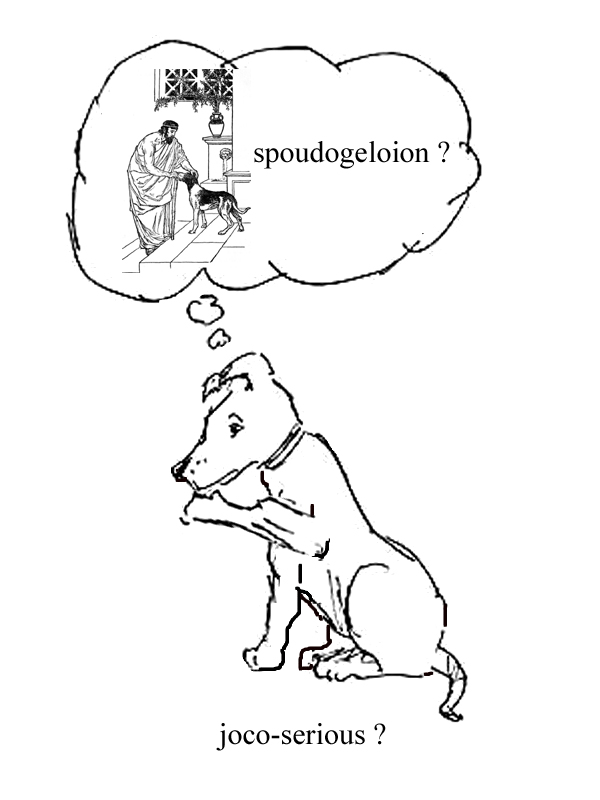

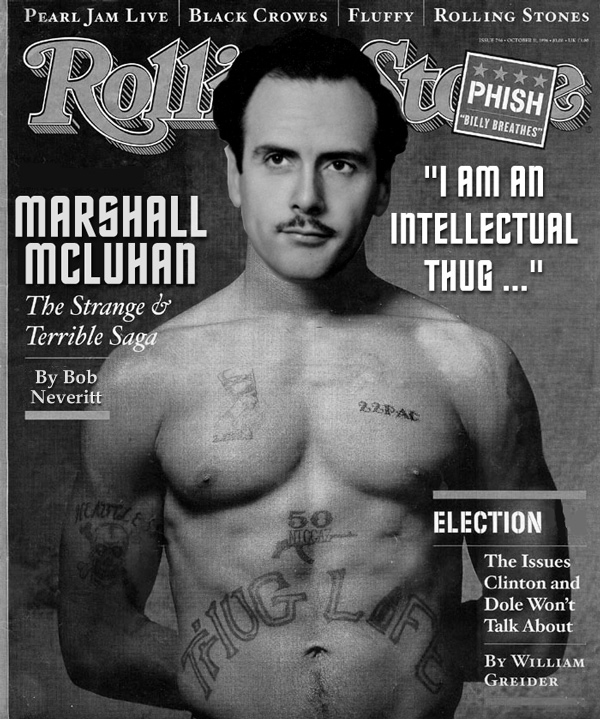
My father decided in the sixties that he would try as much as he could to present his ideas in an aphoristic style. Aphorisms, as Francis Bacon said, are incomplete, a bit like cartoons. They are not filled-out essay writing that is highly compressed. The aphorism is a poetic form that calls for a lot of participation on the part of the reader. You have to chew on a aphorism and work with it for a while before understanding it fully. A good aphorism could keep you busy for a week – kicking it around, playing with it, exploring it, taking it apart to see what you can get out of it. And applying it here, and everywhere. My father deliberately chose this form of statement because he wanted to teach, not tell or entertain. He said,
"For instruction, you use incomplete knowledge so people can fill things in – they can round it out and fill it in with their own experience."
If what you want to do is simply to tell people something, then by all means spell it out in the connected essay. But if you want to teach, you don't do that. There's no participation in just telling: that's simply for consumers – they sit there and swallow it, or not. But the aphoristic style gives you the opportunity to get a dialogue going, to engage people in the process of discovery.
– Eric McLuhan, in BENEDETTI, Paul et DEHART, Nancy (1996). Foward Through the Rearview Mirror: reflections on and by Marshall McLuhan, Scarbourough: Prentice Hall Canada Inc., p. 45

"My canvasses are surrealist, and to call them "theories" is to miss my satirical intent altogether."

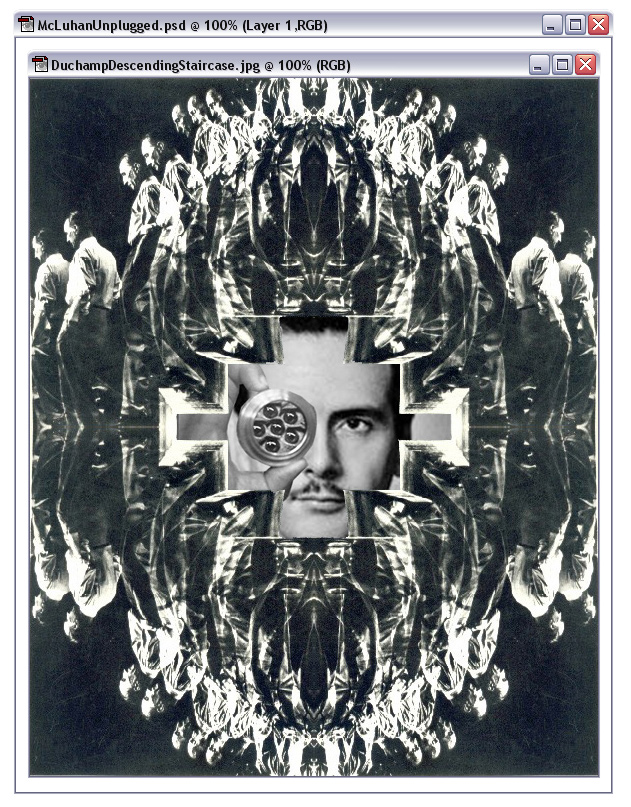

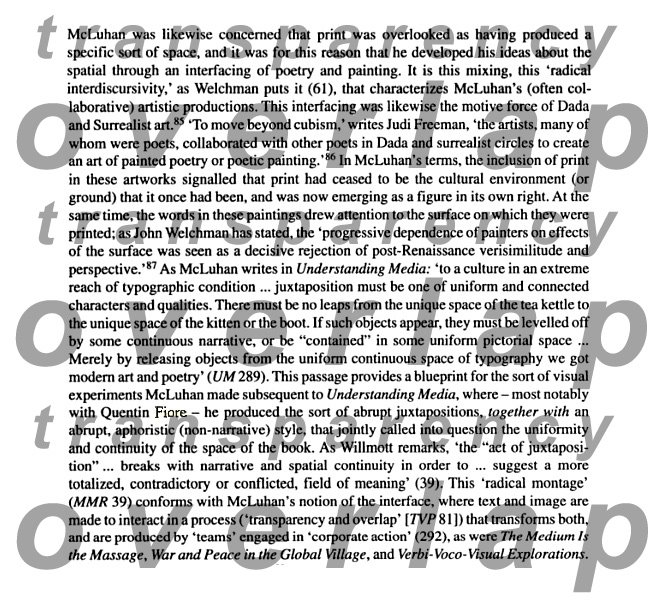
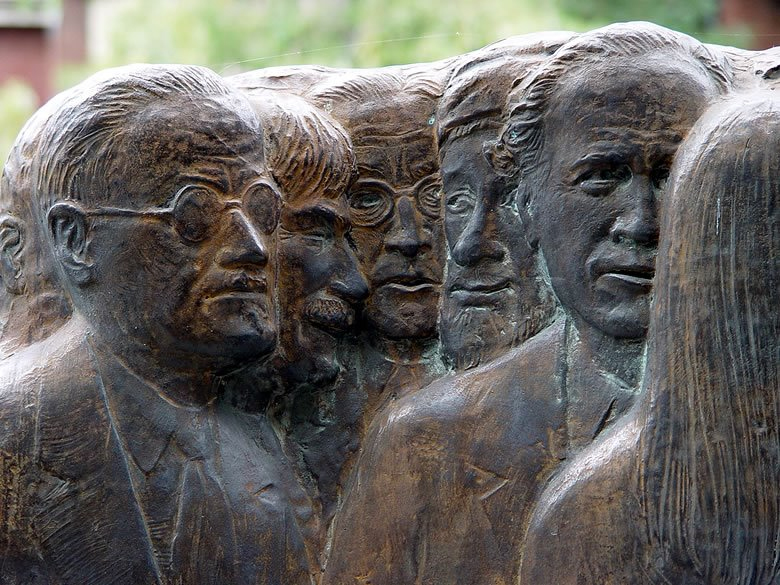

Ezra Pound: "Nothing short of divine vision or a new cure for the clap can possibly be worth all that circumambient peripherisation."















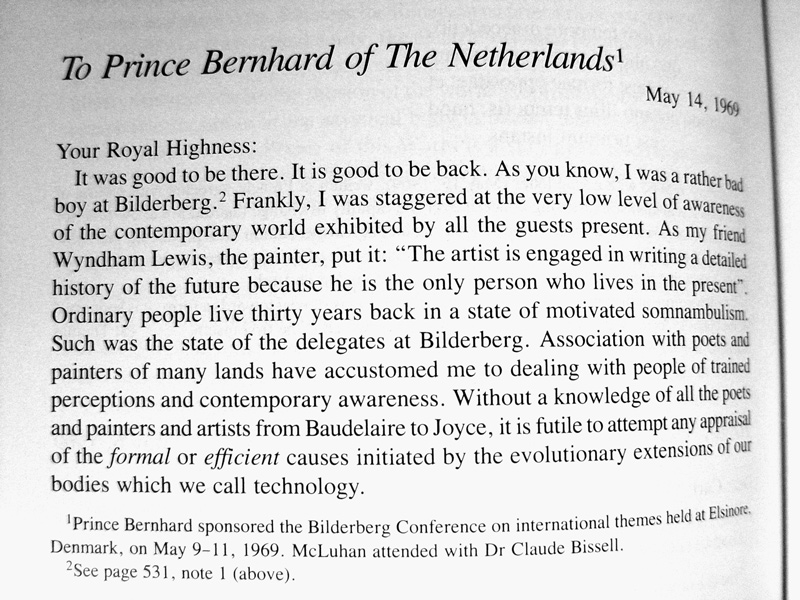
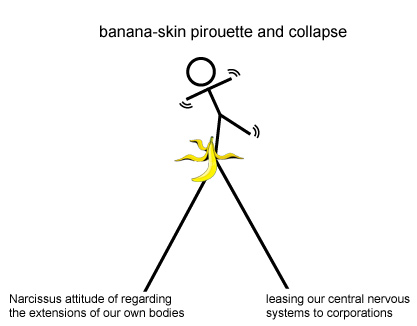
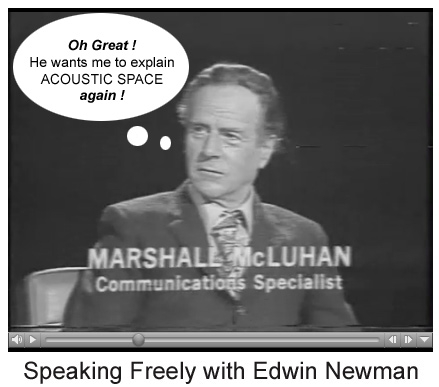
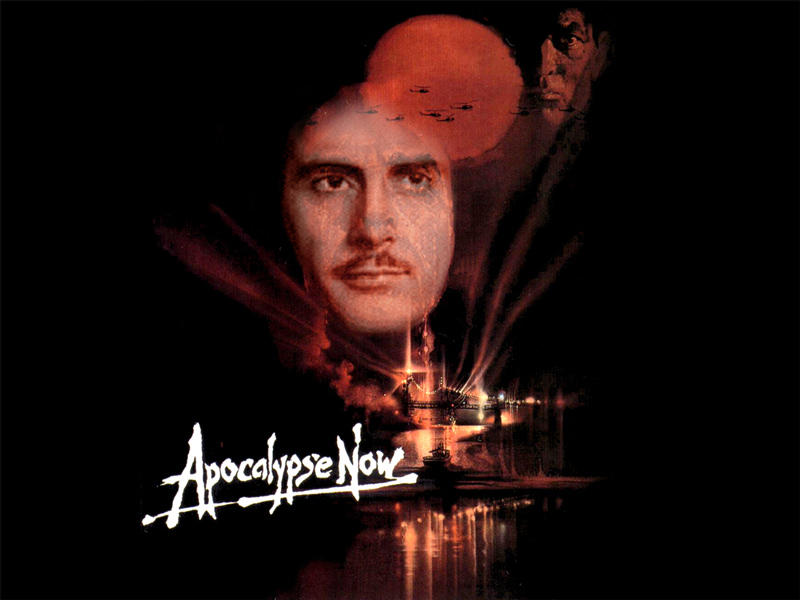
the global village is populated with 'discarnate' human beings who no longer exist
as physical presences; instead the electronic or discarnate person is simply an image
or an information pattern, nothing more ...
- Marshall McLuhan



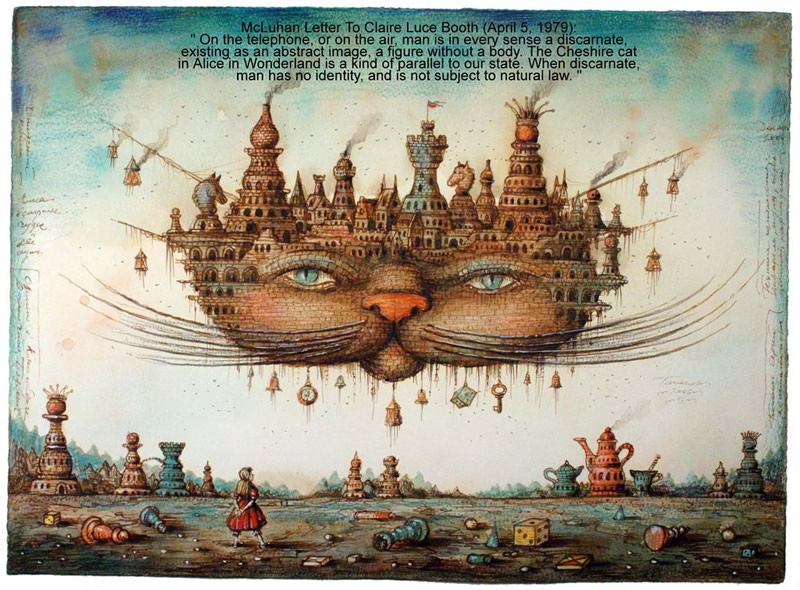
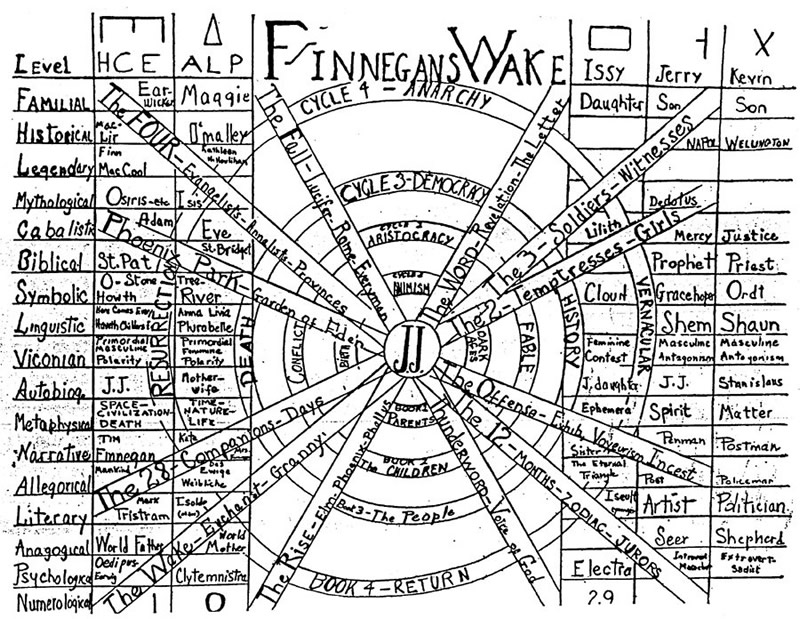
"... in experimental art, men are given the exact specifications of coming violence to their own psyches from their own counter- irritants or technology. For those parts of our selves that we thrust out in the form of new invention are attempts to counter or neutralize collective pressures and irritations. But the counter- irritant usually proves a greater plague than the initial irritant, like a drug habit. And it is here that the artist can show us how to "ride with the punch," instead of "taking it on the chin." It can only be repeated that human history is a record of "taking it on the chin."

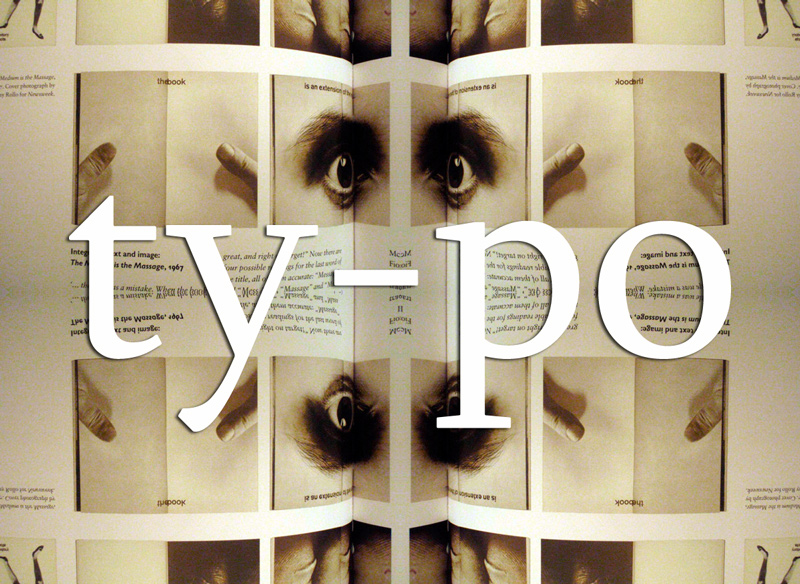
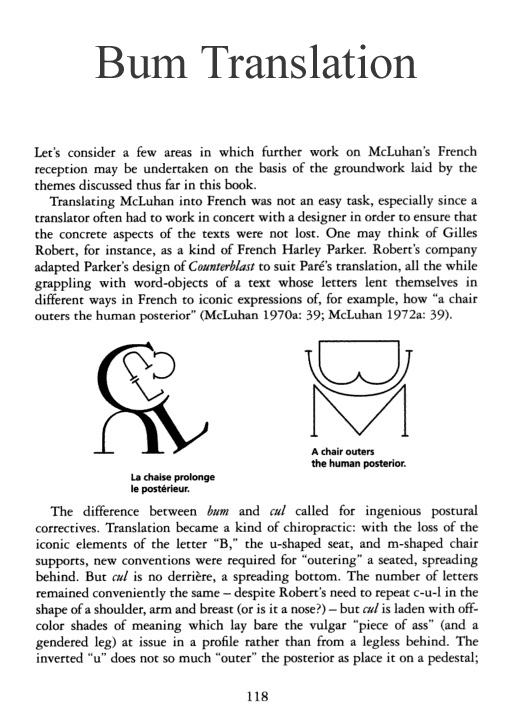
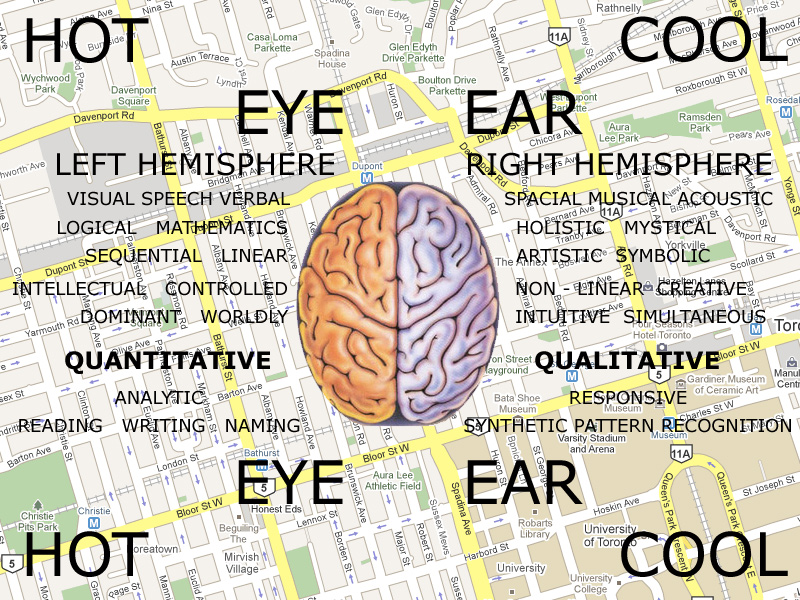



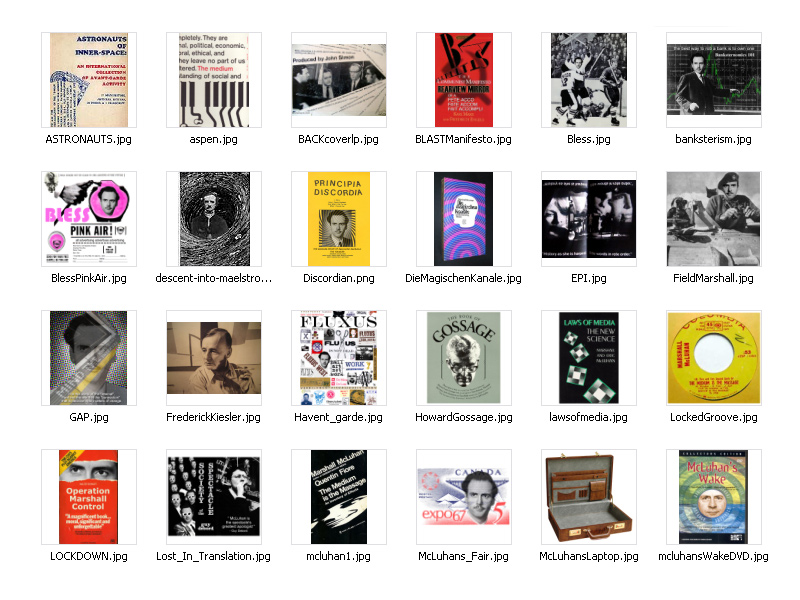
SSSStarting off behind with an end in view
prairie wet nursus came quick with a message in their mouths.
triangular Racketeers unfurl threelegged garbagecans
sworming with pomefructs ... They tally plausible whatsthats.
Somedivide dittoh pricker Paddy squattor
sumthelot bottlogger anntisquattor
Somedivide prittoh dicker squaddy Pattor
sumthelot anntilogger bottsquattor
oh what a meanderthalltale unleavenweight !
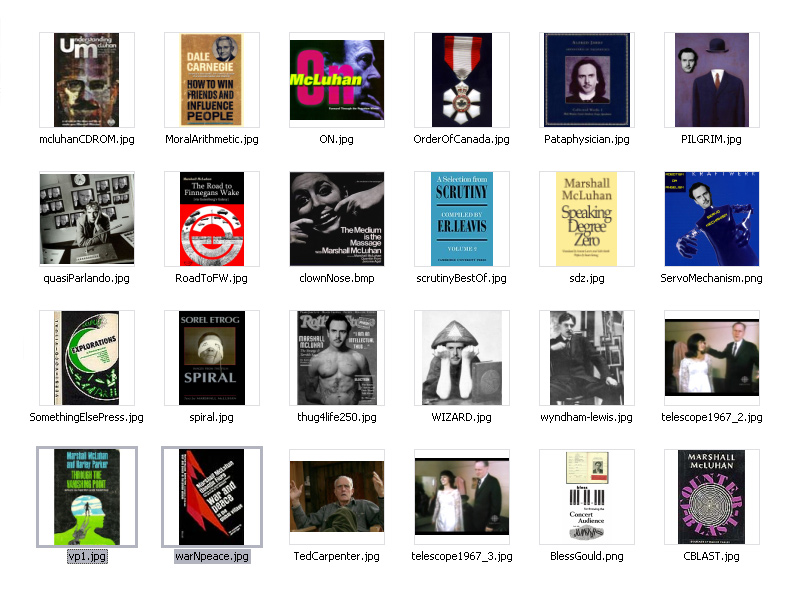
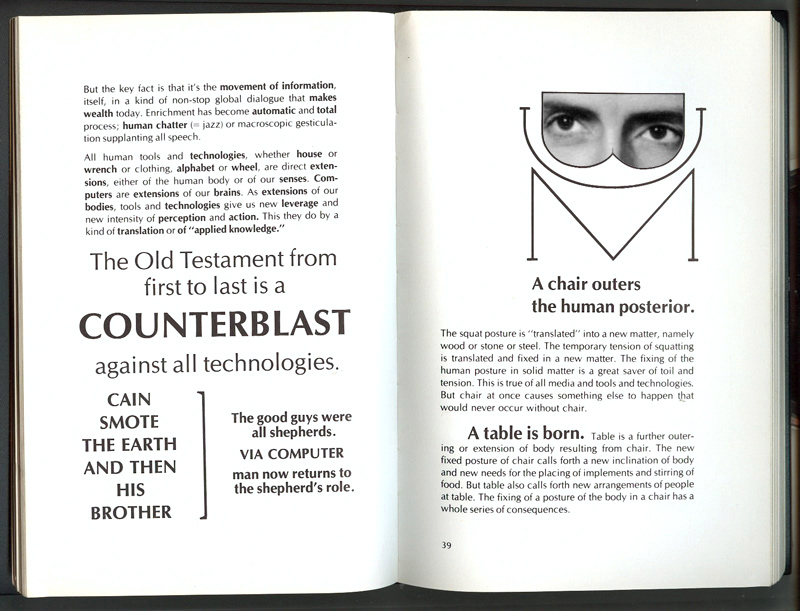
"What may emerge as the most important insight of the twenty-first century is that man was not designed to live at the speed of light. Without the countervailing balance of natural and physical laws, the new video-related media will make man implode upon himself. As he sits in the informational control room, whether at home or at work, receiving data at enormous speeds — imagistic, sound, or tactile — from all areas of the world, the results could be dangerously inflating and schizophrenic. His body will remain in one place but his mind will float out into the electronic void, being everywhere at once in the data bank. Discarnate man is as weightless as an astronaut but can move much faster. He loses his sense of private identity because electronic perceptions are not related to place. Caught up in the hybrid energy released by video technologies, he will be presented with a chimerical “reality” that involves all his senses at a distended pitch, a condition as addictive as any known drug. The mind, as figure, sinks back into ground and drifts somewhere between dream and fantasy. Dreams have some connection to the real world because they have a frame of actual time and place (usually in real time); fantasy has no such commitment."
-MM : The Global Village, page 97
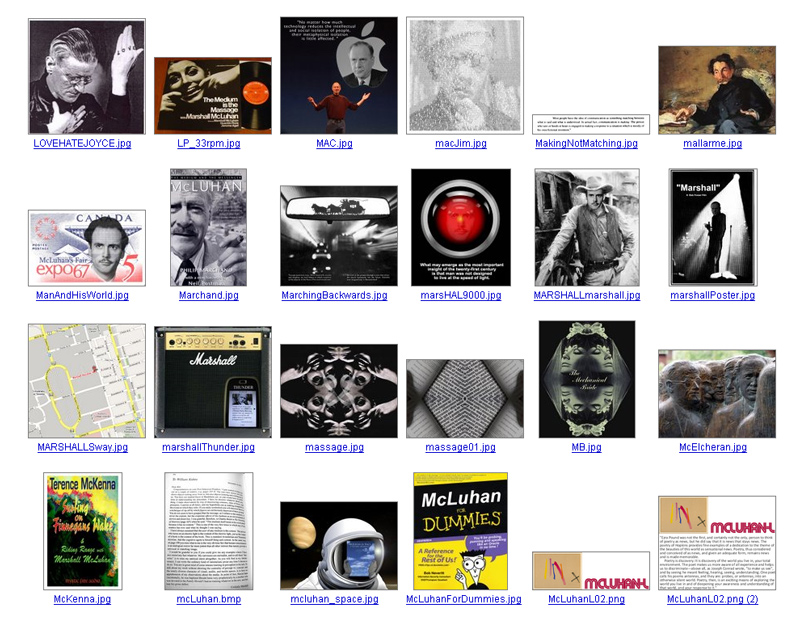
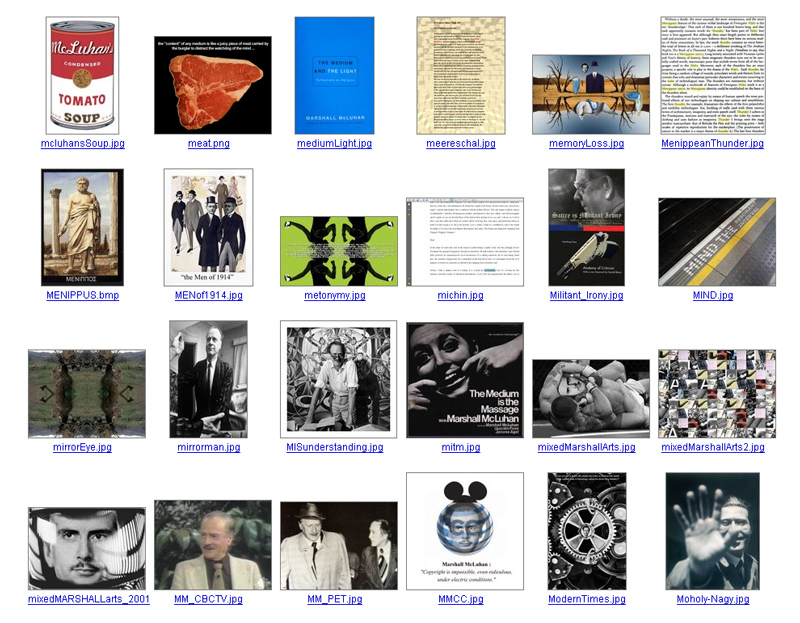
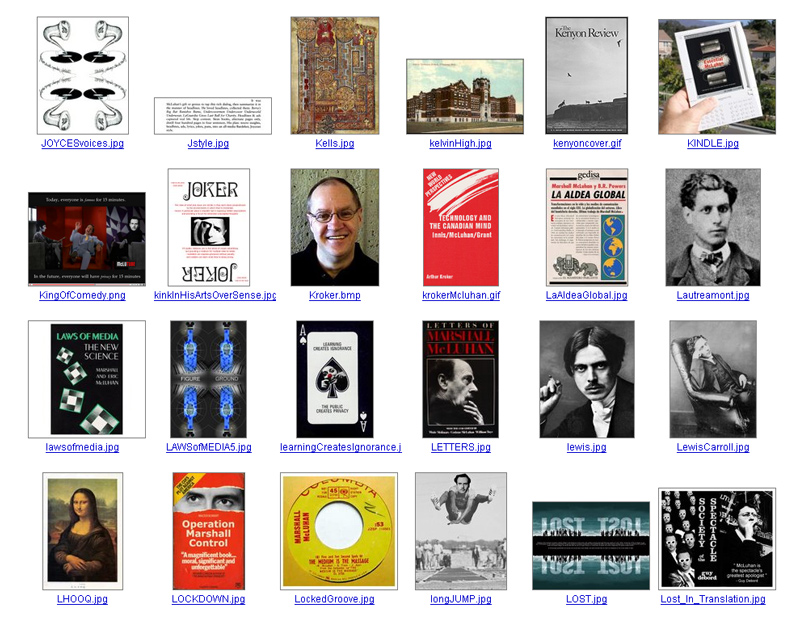
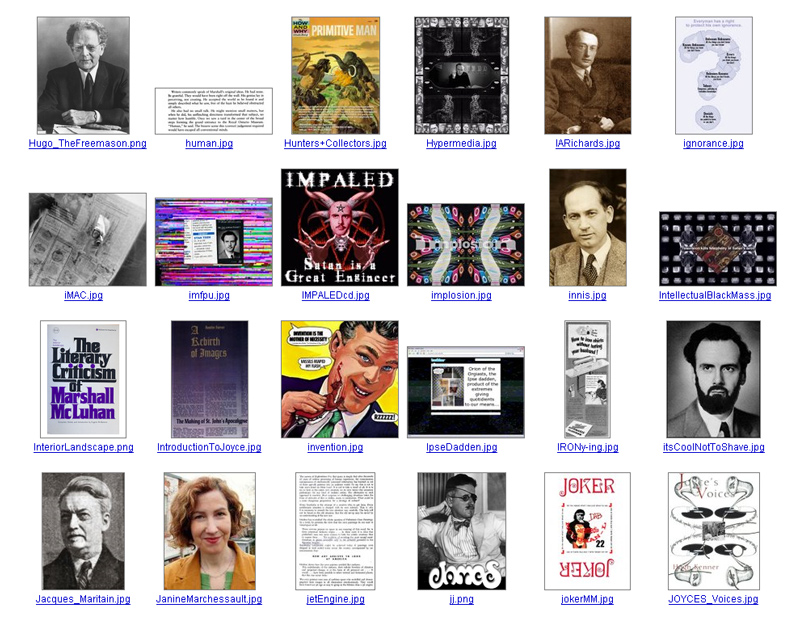
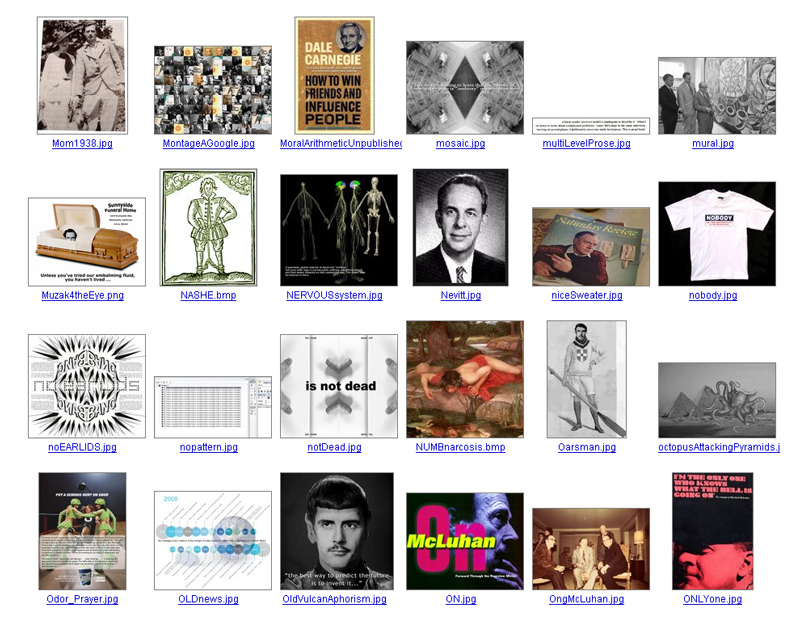
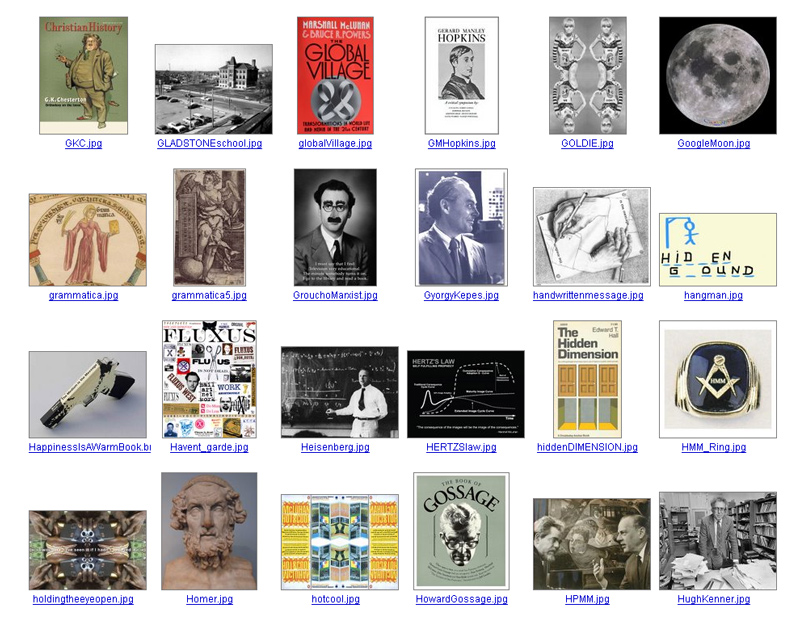
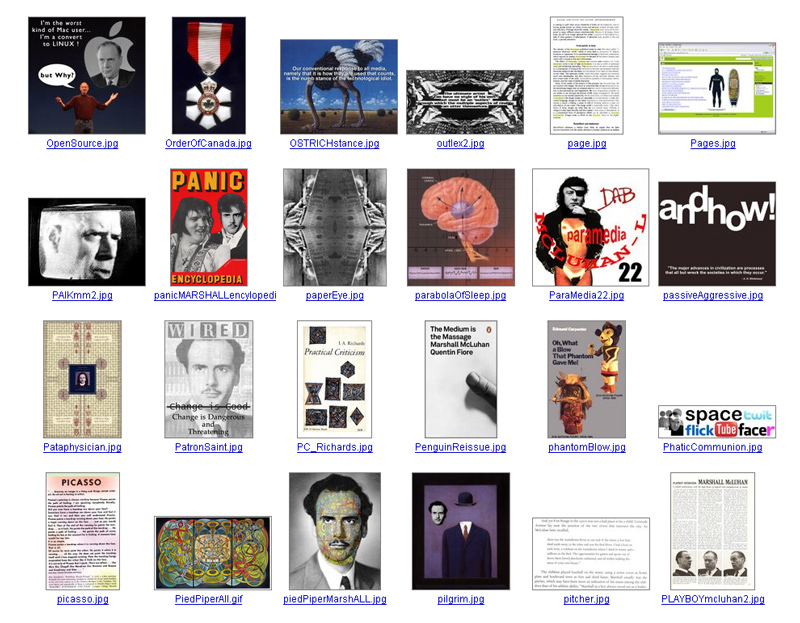
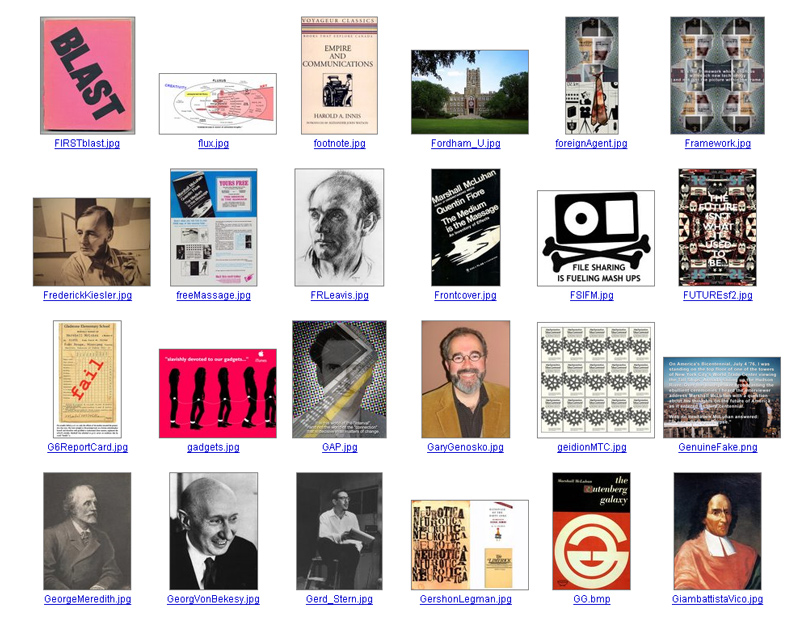
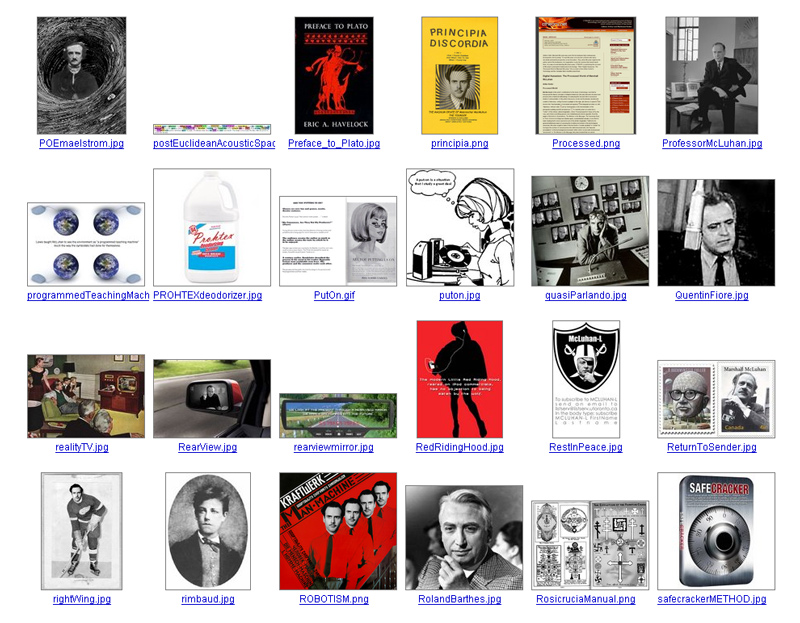
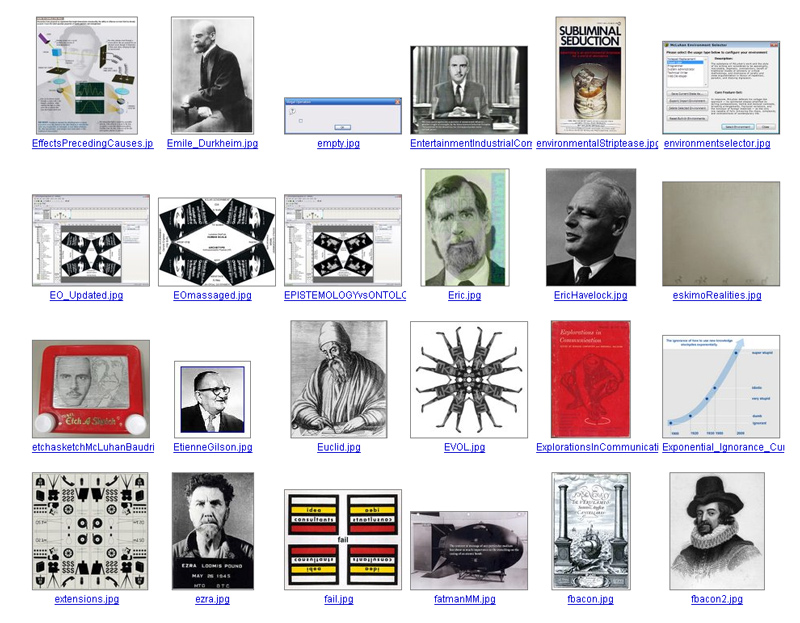
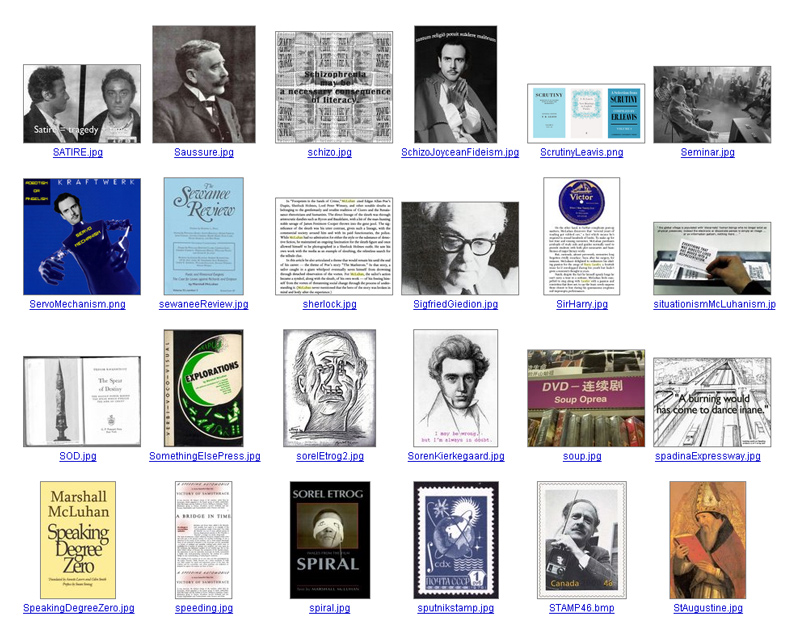
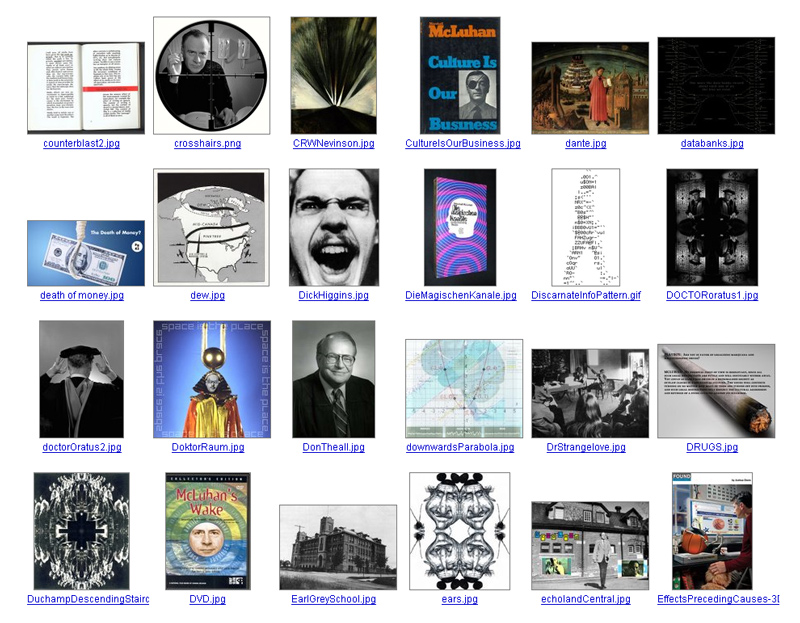
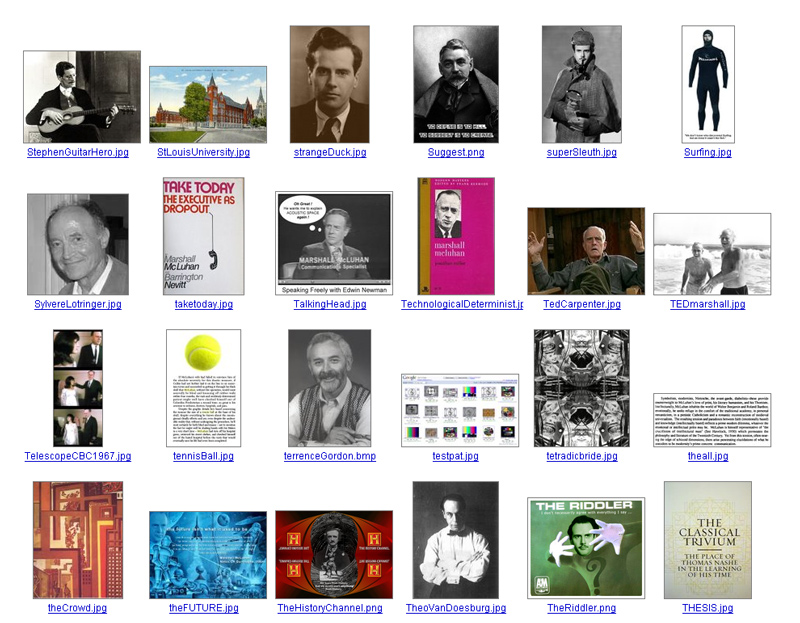
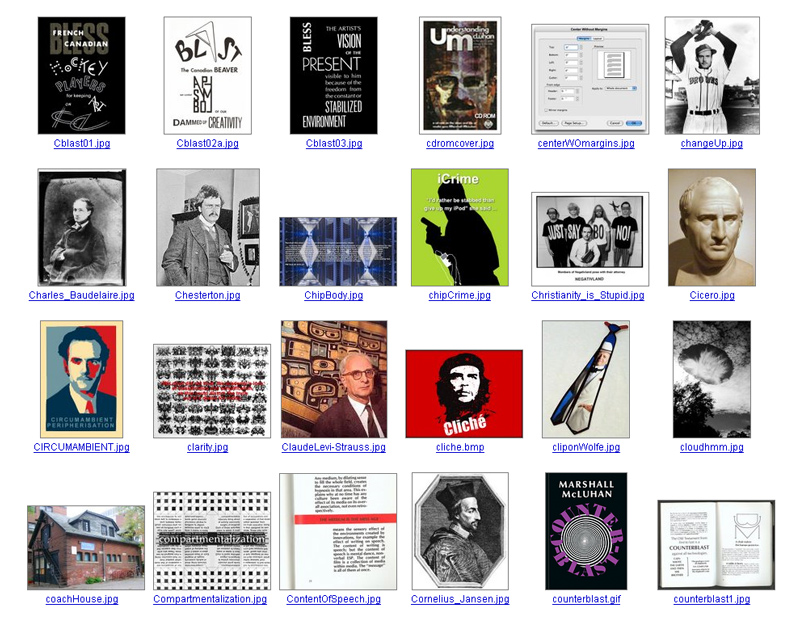
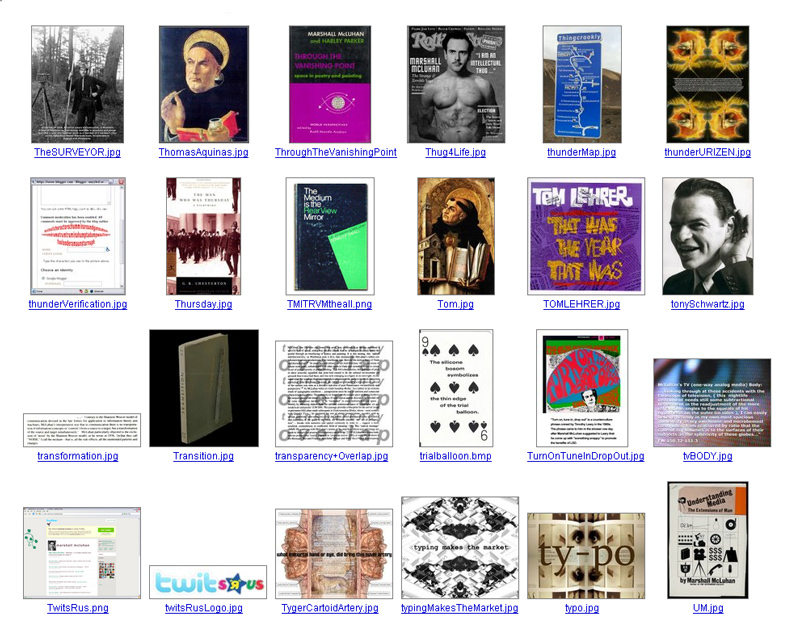
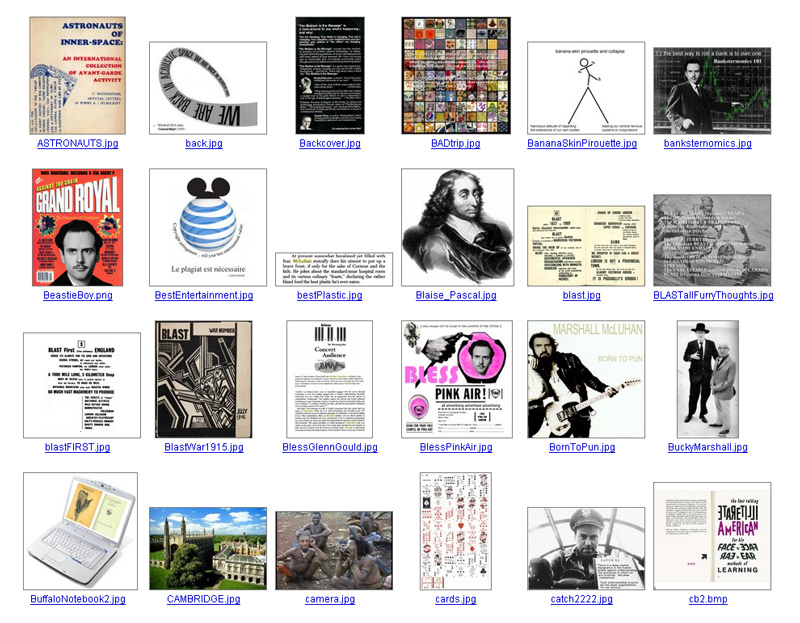
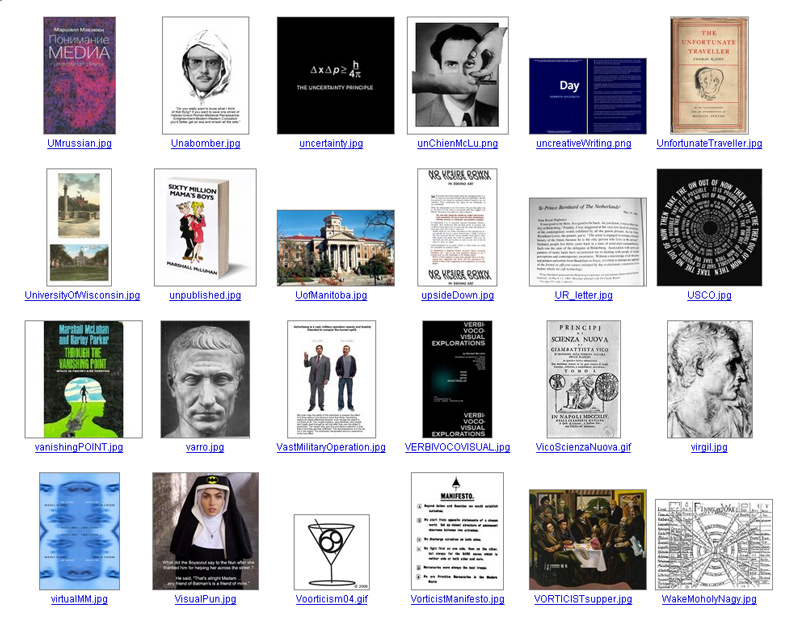
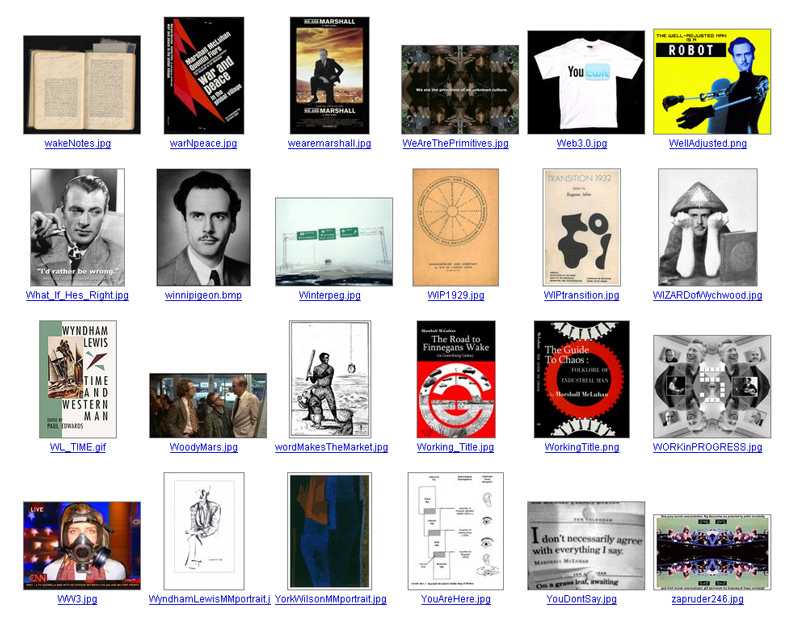
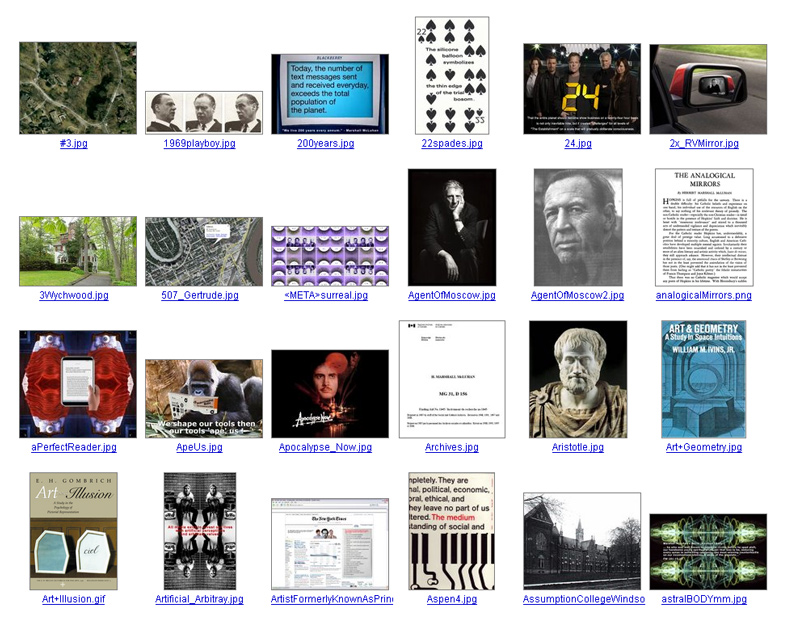
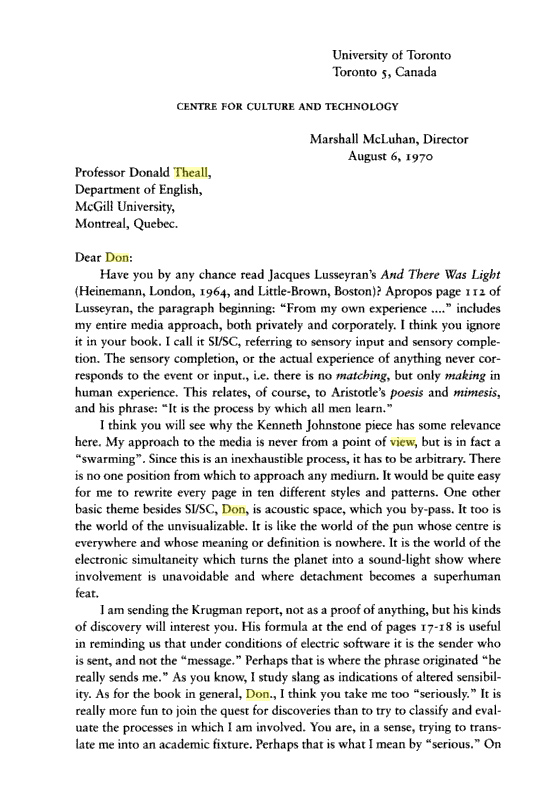
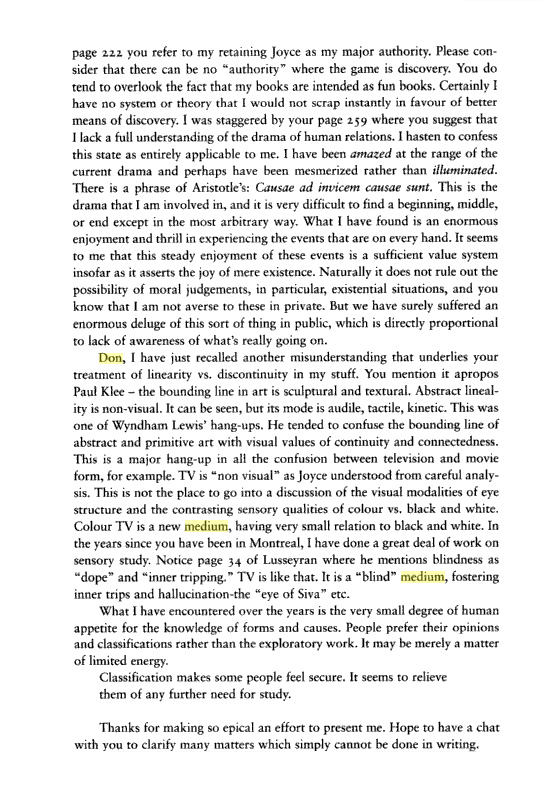
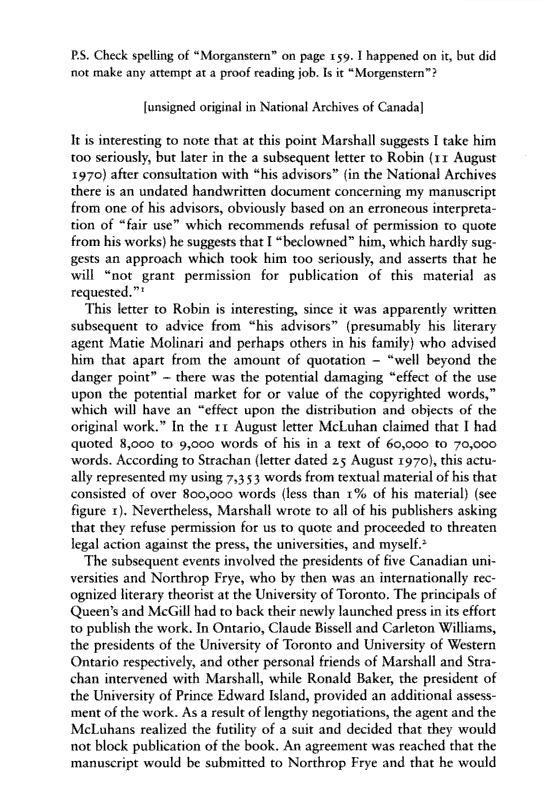
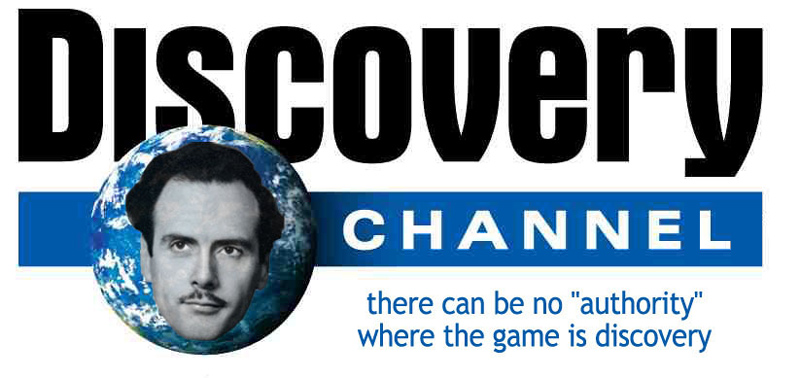
The following is a sample of the many "sheets" McLuhan 'mimeographed' and sent periodically to a small mailing-list of people who shared his interests. He often personalized these sheets with hand writtten comments at the end.
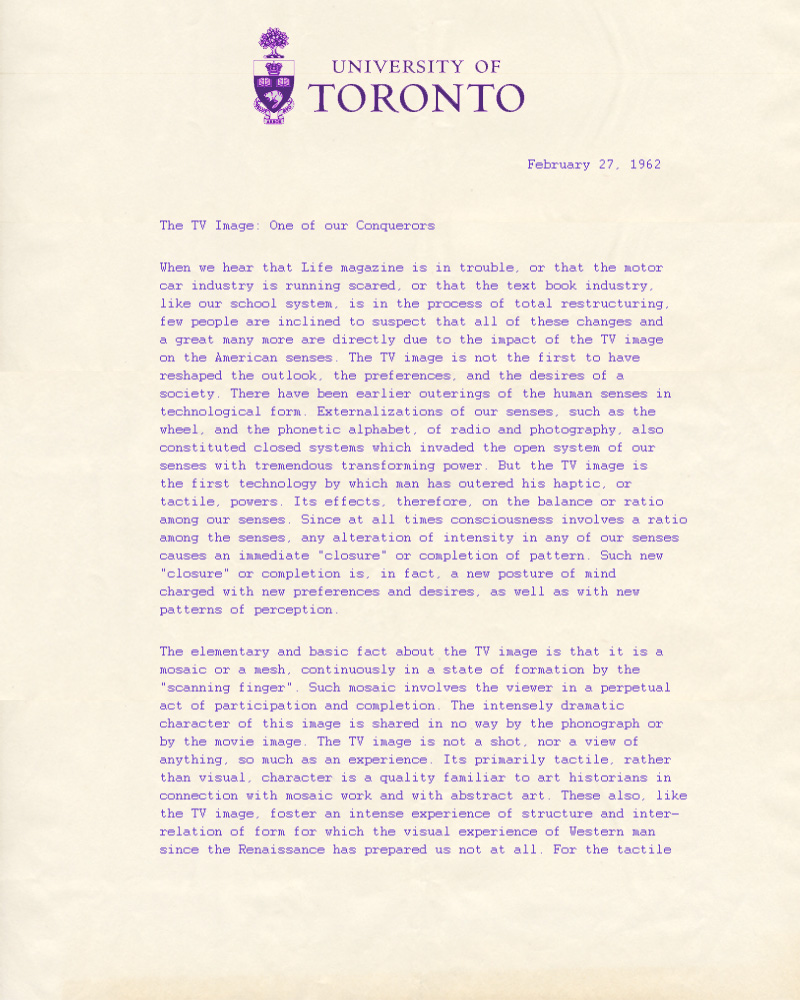
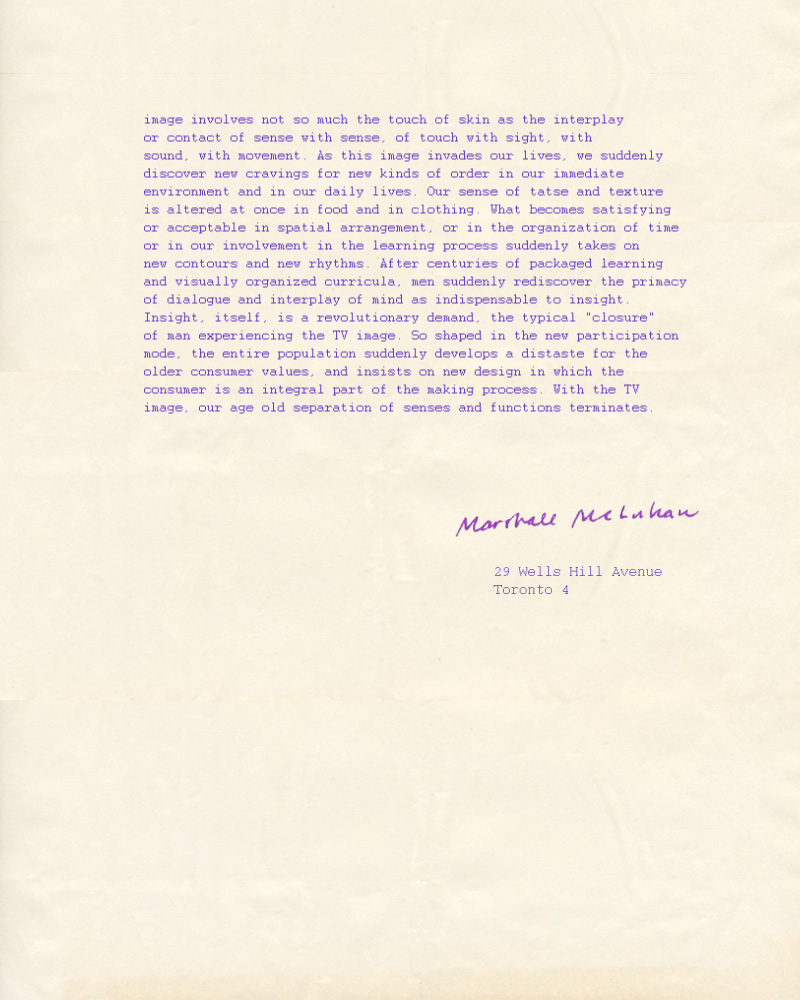
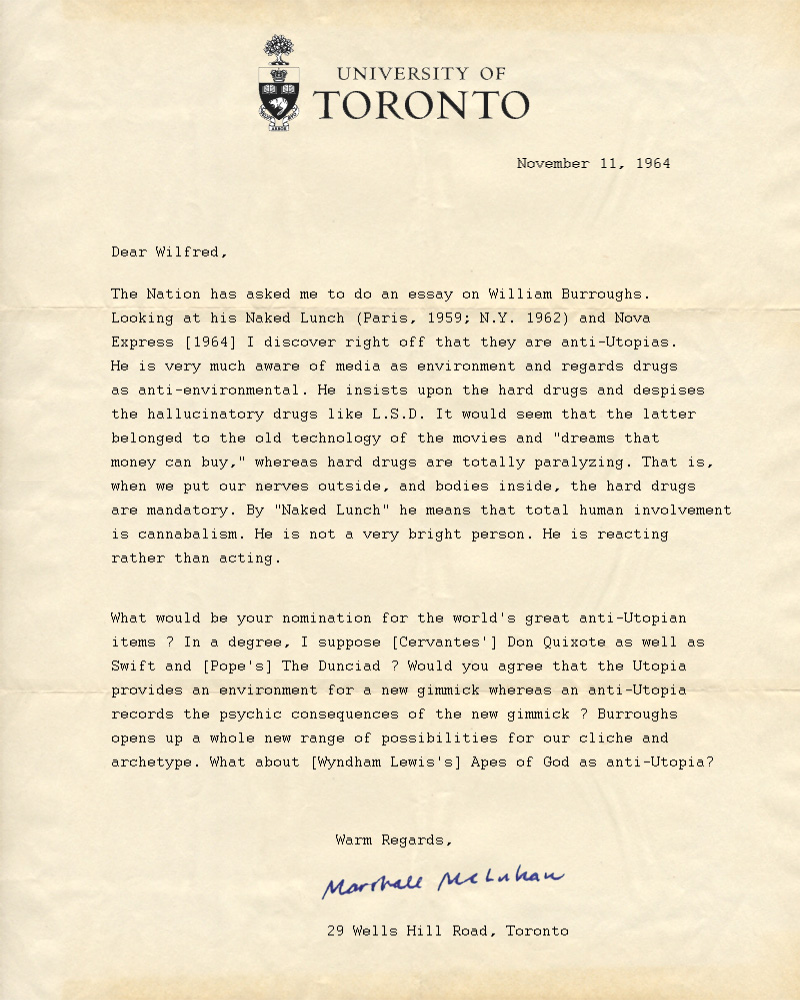
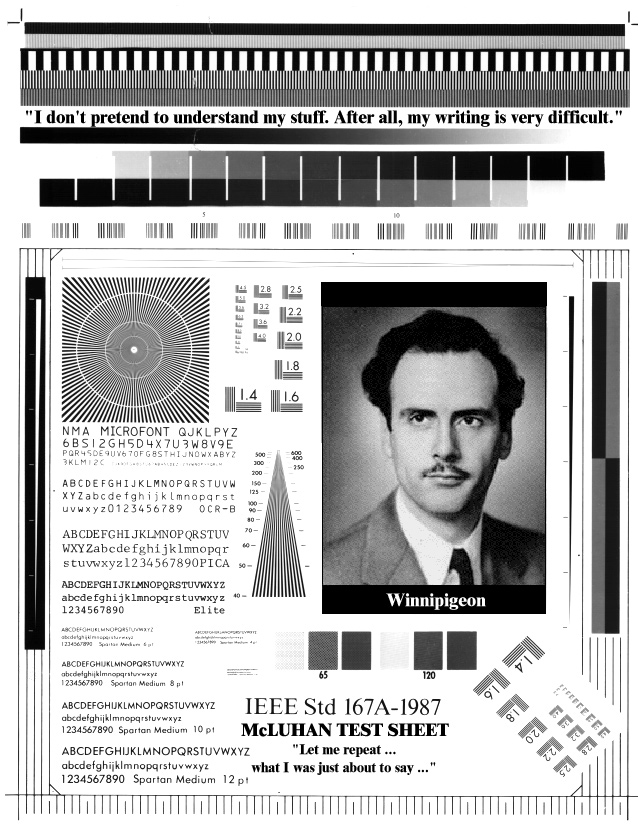

note to dear reader : HERE ENDETH THE PREFACE
 "Electricity has made angels of us all. Not angels in the Sunday school sense of being good or having wings, but spirit, freed from flesh, capable of instant transportation anywhere. The moment we pick up a phone, we’re nowhere in space—everywhere in spirit. That is Saint Augustine’s definition of God: a being whose center is everywhere, whose borders are nowhere."
"Electricity has made angels of us all. Not angels in the Sunday school sense of being good or having wings, but spirit, freed from flesh, capable of instant transportation anywhere. The moment we pick up a phone, we’re nowhere in space—everywhere in spirit. That is Saint Augustine’s definition of God: a being whose center is everywhere, whose borders are nowhere." Carpenter on Anthropological Method : “the approach I have recommended is generally called ‘mystical’ or ‘subjective’ or ‘insight without method....That competent fieldwork should be called ‘mystical’ and incompetent fieldwork called ‘scientific’ is one of the more remarkable features of our profession.”
Carpenter on Anthropological Method : “the approach I have recommended is generally called ‘mystical’ or ‘subjective’ or ‘insight without method....That competent fieldwork should be called ‘mystical’ and incompetent fieldwork called ‘scientific’ is one of the more remarkable features of our profession.” "In the world of electronic technology we humbly encounter the primitive as avant-garde. This search for the primitive is surely one of the most remarkable features of our age. It’s as if we feared we had carried too far our experiment in rationalism, but wouldn’t admit it. And so we called forth other cultures in exotic and disguised forms to administer all of those experiences suppressed among us."
"In the world of electronic technology we humbly encounter the primitive as avant-garde. This search for the primitive is surely one of the most remarkable features of our age. It’s as if we feared we had carried too far our experiment in rationalism, but wouldn’t admit it. And so we called forth other cultures in exotic and disguised forms to administer all of those experiences suppressed among us."- Intermediate Period Influences in the Northeast. (PhD Thesis, U Penn, 1950)
- Eskimo. (with Robert Flaherty, 1959)
- Explorations in Communication, An Anthology. (co-edited with Marshall McLuhan, 1960)
- They Became What They Beheld. (1970)
- Oh, What a Blow That Phantom Gave Me! (1972)
- Eskimo Realities (1973)
- "The Tribal Terror of Self-Awareness." Pp. 451–461. In: Paul Hockings, ed., Principles of Visual Anthropology. (1975a)
- "Collecting Northwest Coast Art." pp. 8–27. In: Bill Holm & William Reid. Form and Freedom: A Dialogue on Northwest Coast Indian Art. (1975b)
- In the Middle, Qitinganituk: The Eskimo Today. (with Stephen G. Williams, 1983)
- Social Symbolism in Ancient and Tribal Art. (with Carl Schuster; 3 Parts, 12 vols., 1986–1988)
- Patterns That Connect:Social Symbolism in Ancient & Tribal Art. (1996)
- "19th Century Aivilik/Iglulik Drawings." pp. 71–92. In Fifty Years of Arctic Research: Anthropological Studies. Eds. R. Gillberg and H.C. Gullov. Copenhagen: The National Museum of Denmark. (1997)
- "Arctic Witnesses." pp. 303–310. In Fifty Years of Arctic Research: Anthropological Studies. Eds. R. Gillberg and H.C. Gullov. Copenhagen: The National Museum of Denmark. (1997)
- "That Not-So-Silent Sea." pp. 236–261. In: Donald Theall. The Virtual Marshall McLuhan. (2001)
- "European Motifs in Protohistoric Iroquois Art." pp. 255–262. In: W.H. Merrill and I. Goddard, eds., Anthropology, History, and American Indians: Essays in Honor of William Curtis Sturtevant. (2002)
- Norse Penny. (2003a)
- Comock: The True Story of an Eskimo Hunter. (with Robert Flaherty, 2003b)
- Two Essays: Chief & Greed. (2005)
- "Marshall." pp. 179–184. Explorations in Media Ecology, Vol.5, No.3 (2006)
- Upside Down: Arctic Realities. Ed. Edmund Carpenter. Houston: Menil Foundation/Yale U Press. (2011)





 US Marine Corps 1942 - 1946
US Marine Corps 1942 - 1946Carpenter and McLuhan would often walk around the city of Toronto indulging in their penchant for "perceiving patterns" in whatever they saw. Carpenter describes one such outing on a Toronto streetcar:
There were all the little widows in black, all the mean faces--it was a mean life then, and the faces reflected it--and Marshall began to talk about the ads on the streetcar in a very loud voice. He pointed to an ad of a girl drinking a Coke with some man watching her, and he said, "Coke sucker." I said, "Marshall, lower your voice." He was totally oblivious to the sound of his voice. And he went down the line and analyzed one ad after another. Everybody just looked straight ahead and pretended they didn't hear him." (qtd. in Marchand, 116)
Here were a couple of media tricksters creating a (barely) "tolerated margin of mess."
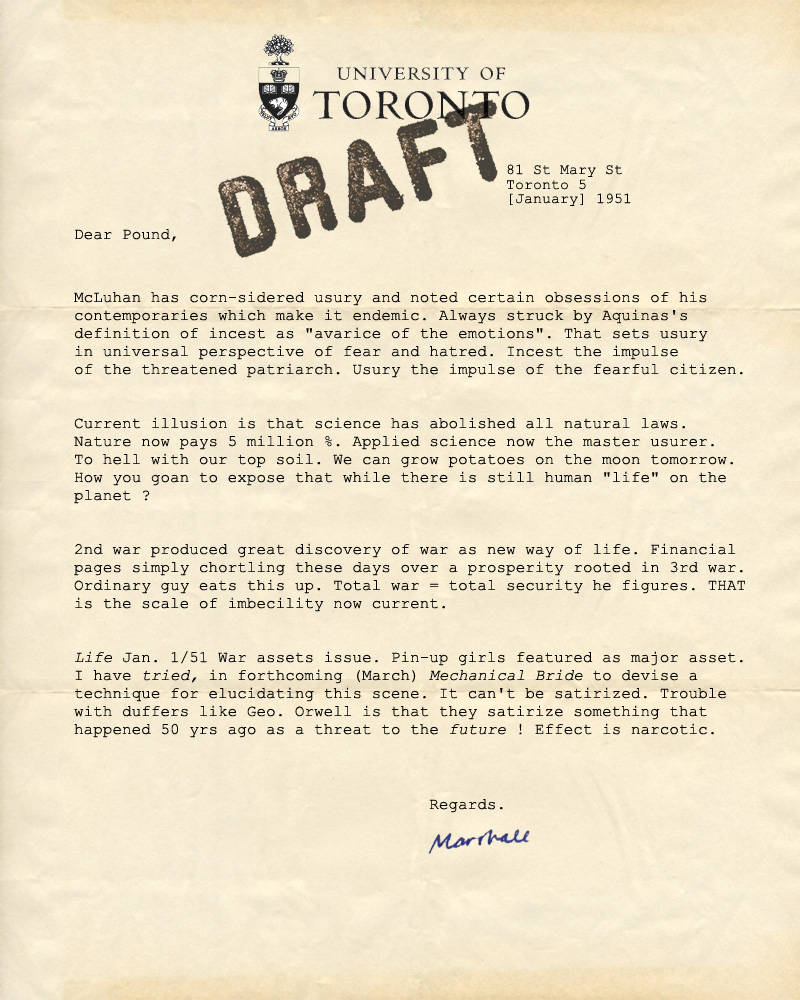


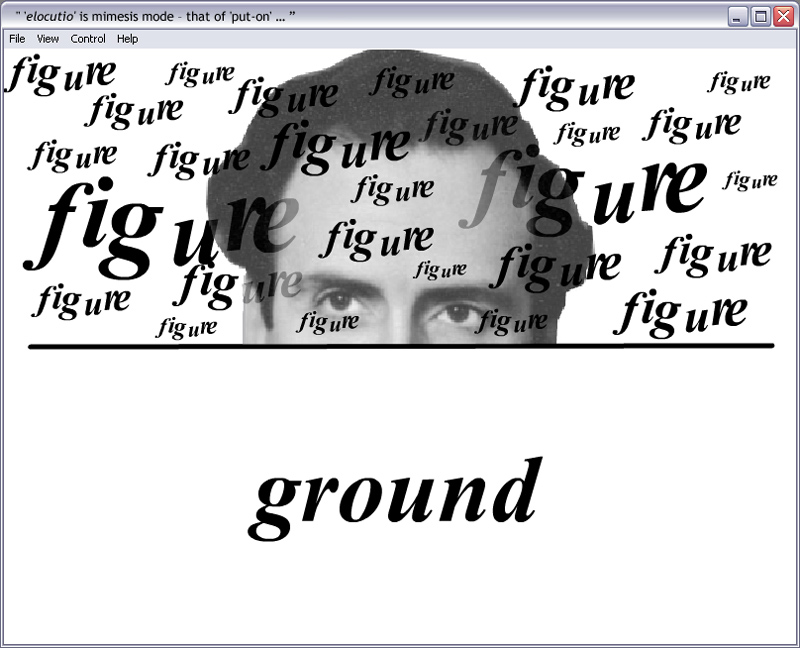
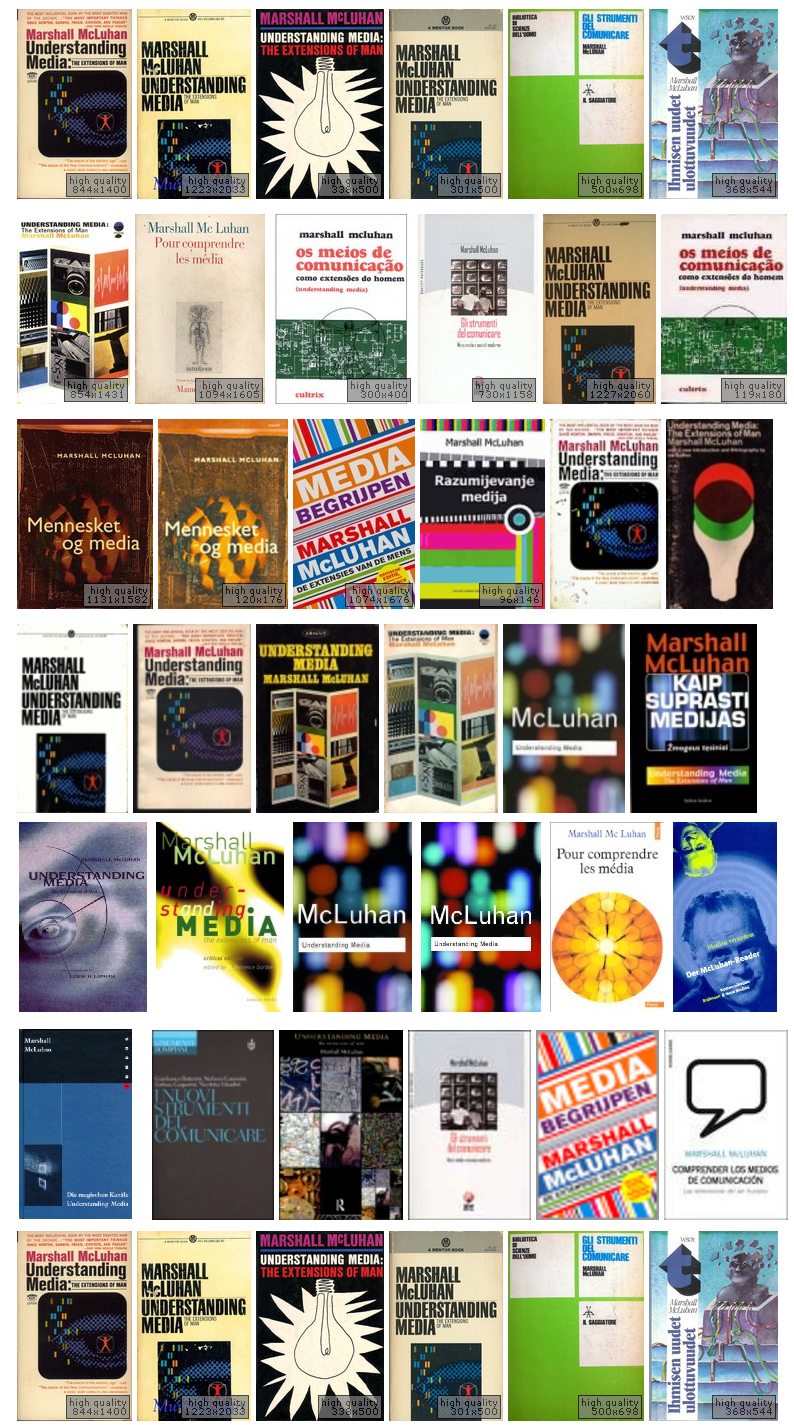


























































































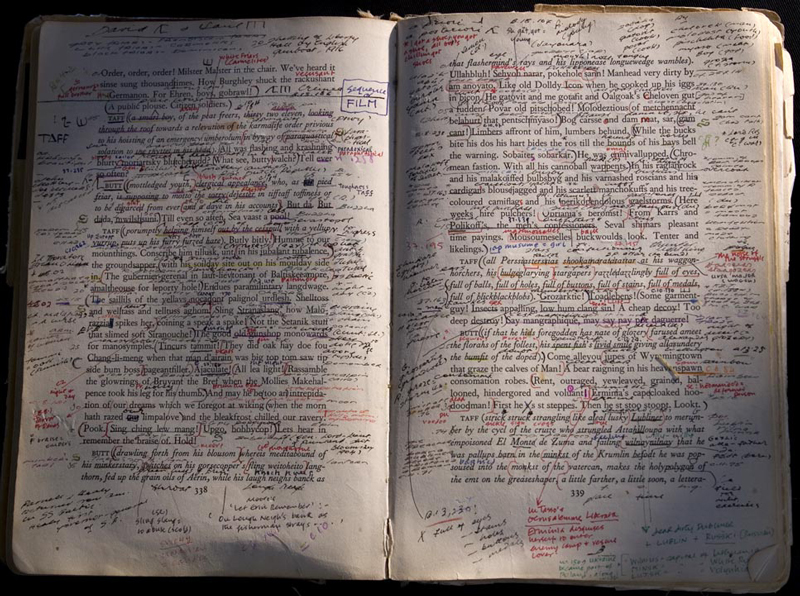
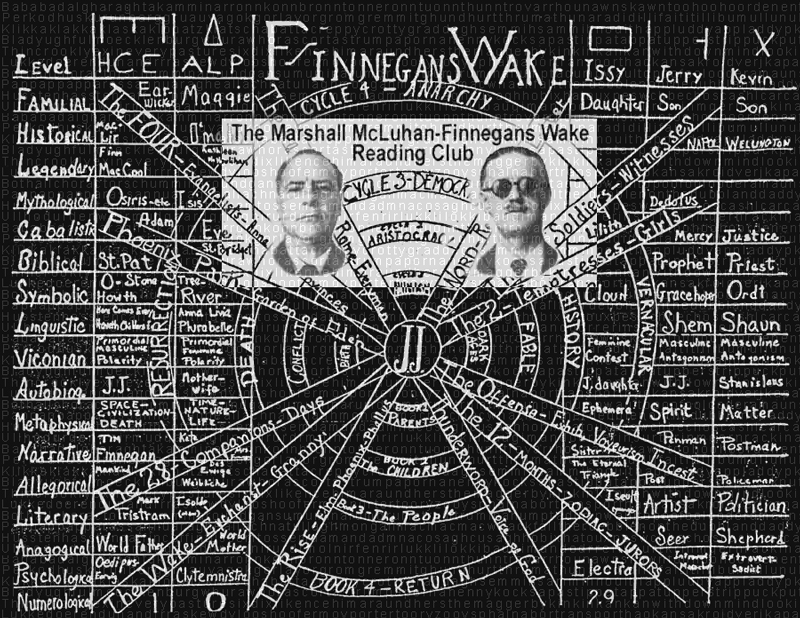









![CENTRIFUGAL[internet] vs CENTRIPETAL [television]](https://blogger.googleusercontent.com/img/b/R29vZ2xl/AVvXsEihYGlZrmdDOhVdxSmbYNtZbrcJ0lwoK1hJXlVdChv4bqaAqj6trw0QPYDvES3xNEMqFvQVRoyewZdglxjL9N-sjisdv66BIw-l4bZYeokiZb7X7G69sj0gLTY_anwHYSku9aa4pSHtpox4/s1600/skating.png)



























































































No comments:
Post a Comment